- Shopping Cart 0

Marine Fuel Gauges

Fuel gauges are important instruments keeping you aware of the fuel efficiency and performance of your boat. It can be a gauge showing the current volume of hydrocarbons in the tank , pressure in the rail, air-to-fuel ratio, etc. While the fuel level gauge gives you a general idea of how much gas or diesel remains in the vessel, the information from other instruments can be more critical for engine performance and even fire safety. For instance, the wrong air-fuel mixture can be the reason for serious malfunctions or even engine failure, while insufficient pressure can be the symptom of leaks.
To keep engine performance, safety, fuel consumption, and other aspects under control, your gauges have to be in good condition and provide the necessary accuracy. If any of them goes wrong, visit our online store. On our virtual shelves, you will find a wide range of marine fuel gauges sourced from leading brands. Manufactured from strong, quality materials, they feature high accuracy and can withstand harsh marine conditions for years to come. Last but not least, they look stylish and offer some additional advantages such as convenient mounting or lighting for improved visibility at night.
Featured Brands

Related Categories

Open to the Public!

- Engine_Fuel & Props
- Fuel Tanks & Systems
Fuel Senders & Gauges

Moeller Electric Fuel Sending Units
Moeller Marine Swingarm Electric Fuel Sending Units These Moeller Swingarm Fuel Sending Units gather fuel level information from a float which is read on a dash-mounted gauge. These units have been pre-inspected to guarantee full range of calibrated...

Moeller Reed Switch Fuel Sending Unit
Moeller Reed Switch Fuel Sending Unit Collect fuel level information more consistently than swingarm senders by taking the measurement from the float-which is still a moving part. However the fluctuation is much less because the range of motion is...

Moeller 5 Hole Gasket for Electric Sending Units
Moeller Marine 5 Hole Gasket for Electric Sending Units Moeller Marine universal 5-hole gasket for electric fuel sending units. Comes complete with 10/24 and 10/32 replacement screws and assorted washers.

Moeller Diesel Electric Sending Unit w/ Return
Moeller 035724-10 Diesel Sending Unit with Return To meet the needs of a return line found on diesel and some fuel injection engines, Moeller's patent-pending design ensures all needs are met. Features: Internal components will not rust or...

Moeller Electric Fuel Sending Unit w/Gauge
Moeller Electric 4-28" Fuel Sending Unit w/Gauge The Moeller Electric 4-28" Fuel Sending Unit is one of the industry's best OEM compatible fuel sender with a remote gauge. A complete line of universal swing arm fuel senders that can range from 4" up to...

Faria Newport SS 2" Fuel Level Gauge - E-1/2-F
Newport SS 2" Fuel Level Gauge - E-1/2-FThe Newport Stainless Steel (SS) family of marine gauges is a classic style of gauge, engineered to be the new Modern Retro. Designed with the latest fog resistant features, this Retro Style gauge far...

VDO Reed Switch Fuel Sender - 150mm - 240-33 Ohm
Reed Switch Fuel Sender - 150 MMMost aftermarket fuel senders use a rotating float arm and resistance cards to measure the amount of fuel in a tank which can lead to erratic pointer movements. This revolutionary design comes with many benefits!...
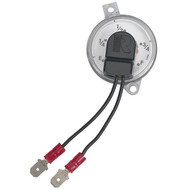
Moeller 035760-10 Electrical Fuel Sender Conversion Gauge
Moeller 035760-10 Mechanical to Electrical Fuel Sender Conversion Gauge The Moeller Mechanical to Electrical Fuel Sender Conversion Gauge converts the fuel level reading from the standard direct site gauge to the electronic dash mounted gauge...

VDO Reed Switch Fuel Sender - 180mm - 240-33 Ohm
Reed Switch Fuel Sender - 180mm Most aftermarket fuel senders use a rotating float arm and resistance cards to measure the amount of fuel in a tank which can lead to erratic pointer movements. This revolutionary design comes with many...

Faria Coral 2" Fuel Level Gauge (E-1/2-F)
Coral 2" Fuel Level Gauge (E-1/2-F)Perimeter-lighted Black dial with stylish White and Blue graphics, Black aluminum bezel with burnished leading edge, contoured White pointer, and flat glass lens.Fuel Level gauge operates by sending a low amperage...

VDO Reed Switch Fuel Sender - 350mm - 240-33 Ohm
Reed Switch Fuel Sender - 350 MMMost aftermarket fuel senders use a rotating float arm and resistance cards to measure the amount of fuel in a tank which can lead to erratic pointer movements. This revolutionary design comes with many benefits!...

VDO Pressure Sender 150 PSI Floating Ground - 1/8-27NPT 32/14
Pressure Sender 150 PSI Floating Ground - 1/8-27 NPT Features: Ground - Floating Connection - Knurled Nut Voltage - 6-24V Thread - 1/8-27 NPTF Component Reference No. - 32/14 Max. Pressure Range - 150PSI / 10 bar (10-180Ohm) *Sold as an...
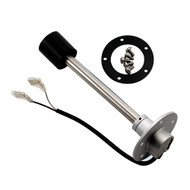
VDO Reed Switch Fuel Sender - 200mm - 240-33 Ohm
Reed Switch Fuel Sender - 200 MM Most aftermarket fuel senders use a rotating float arm and resistance cards to measure the amount of fuel in a tank which can lead to erratic pointer movements. This revolutionary design comes with many benefits!...

VDO Reed Switch Fuel Sender - 230mm - 240-33 Ohm
Reed Switch Fuel Sender - 230 MM Most aftermarket fuel senders use a rotating float arm and resistance cards to measure the amount of fuel in a tank which can lead to erratic pointer movements. This revolutionary design comes with many benefits!...

VDO Reed Switch Fuel Sender - 600mm - 240-33 Ohm
Reed Switch Fuel Sender - 600 MMMost aftermarket fuel senders use a rotating float arm and resistance cards to measure the amount of fuel in a tank which can lead to erratic pointer movements. This revolutionary design comes with many benefits!...

VDO ALAS I Adjustable Fuel Sender - 6-15 3/4" - 240-33 Ohm, w/Low Fuel Warning Contact
ALAS I Adjustable Fuel Sender - 6 to15-3/4" - 240-33 OhmFor a more economical and practical solution for fuel monitoring for tank depths, VDO ALAS I 12/24 V fuel senders are definitely on the level! These fuel senders are engineered with a...

VDO Reed Switch Fuel Sender - 400mm - 240-33 Ohm
Reed Switch Fuel Sender - 400 MMMost aftermarket fuel senders use a rotating float arm and resistance cards to measure the amount of fuel in a tank which can lead to erratic pointer movements. This revolutionary design comes with many benefits!...

VDO Reed Switch Fuel Sender - 300mm - 240-33 Ohm
Reed Switch Fuel Sender - 300 MM Most aftermarket fuel senders use a rotating float arm and resistance cards to measure the amount of fuel in a tank which can lead to erratic pointer movements. This revolutionary design comes with many benefits!...

Faria Sender Fuel Level (American 8"-16") (Single)
Sender Fuel Level (American 8"-16") (Single)Features:8 to 16 in. Fuel Level Sending Unit8 in. to 16 in. tank depthSingle stationFor use with US OHM scale gaugesThis product may not be returned to the original point of purchase. Please contact the...

VDO ALAS Adjustable Fuel Sender - 6-3/4-23" - 240-33 Ohm
ALAS Adjustable Fuel Sender - 6-3/4 to 23" - 240-33 Ohm VDO ALAS 12/24 V adjustable swingarm senders are engineered for severe-duty use. The sender main body features a plated steel construction to help eliminate damage caused by fuel slosh...
Boat Fuel Sending Units
Boat fuel sending units are by far the most popular on the market today, but a new reed style is growing in popularity. The swing arm style is less expensive and can be adjusted to fit most tanks. Moeller offers two size a 4 -12” model and for tanks up to 24”. These can be cut to fit for less than 12” or bolted together for over 12 inches to achieve the desired tank depth. The reed style sending unit must be installed at the proper length for your desired tank depth. While this style is also a bit more expensive, it is more accurate when fuel sloshing occurs. The following information offers some guidance if you are having trouble with a swing arm style boat fuel sending unit.
Fuel gauge not working? Is it the fuel tank sending unit or the gauge itself? Here is a simple trick to check to see where the problem is.
- First locate the sending unit in the tank. You should see 2 wires one on the center stud (power wire +) and the other wire connected to a tab or under a screw holding down the sender (ground wire - ).
- Turn the ignition switch to the power on position (energizing the gauges not starting the engine).
- With the ignition switch on. Go back to the sending unit and with a screwdriver lay it across the center stud to the ground wire. This will complete the circuit and if the sending unit is bad, but the gauge and wiring are good, the gauge will read full. If the gauge needle doesn’t move, the gauge or wiring is bad. Replacing a bad fuel sender is easy.
- Disconnect the battery or turn off your battery switch if applicable. The sender is held in place by 5 machine screws.
- Remove the power and ground wire.
- Remove the five machine screws holding the sender in place. The bolt pattern is a marine standard so for replacement we just need to know the length of the sender.
- When removing the fuel sender and gasket take care to make sure which direction the arm swings.
- Check the length of the sender. Replacement senders are designed to be cut or bolted together to make the desired length.
- Reinstall your new sender with a gasket, again make sure the arm swings in the proper direction. Install your 5 screws torque tight, reconnect the wires, and reconnect the battery.
- Installation complete.
Oops, something went wrong. Please try again.
You are now logged in!
- 2024 BOAT BUYERS GUIDE
- Email Newsletters
- Boat of the Year
- 2024 Freshwater Boat and Gear Buyers Guide
- 2024 Boat Buyers Guide
- 2024 Water Sports Boat Buyers Guide
- 2023 Pontoon Boat Buyers Guide
- Cruising Boats
- Pontoon Boats
- Fishing Boats
- Personal Watercraft
- Water Sports
- Boat Walkthroughs
- What To Look For
- Best Marine Electronics & Technology
- Watersports Favorites Spring 2022
- Boating Lab
- Boating Safety

Troubleshoot Your Boat’s Fuel Gauge
- By John Tiger
- Updated: March 11, 2020
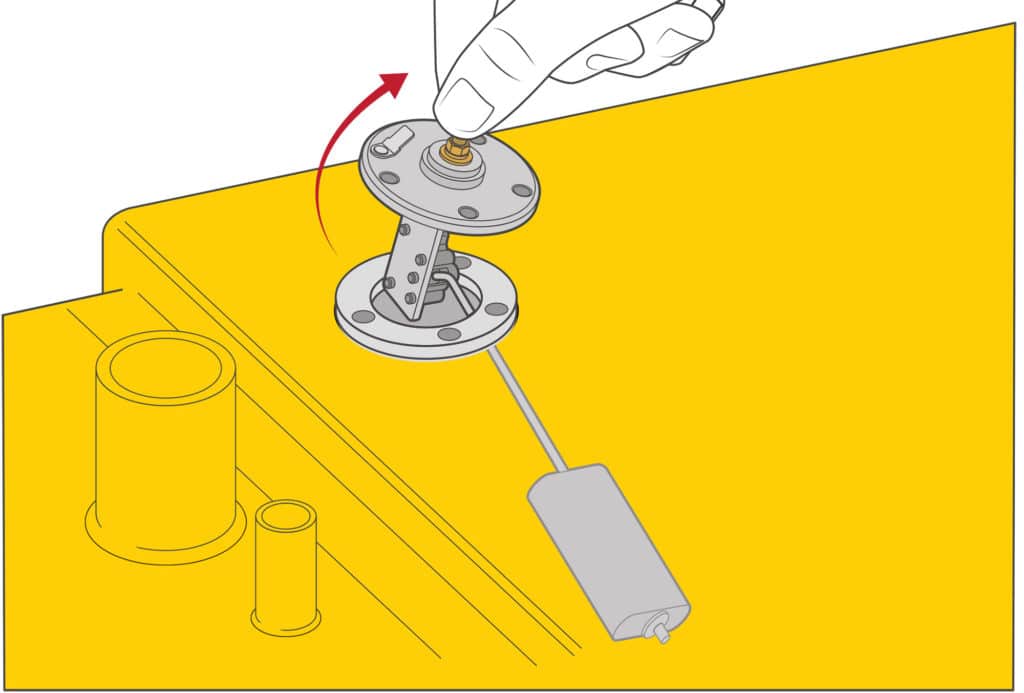
In our marine business, after effecting a repair, we are often asked, “Can you take a look at my fuel gauge too? It’s not working.” It’s a familiar story. Here’s how to troubleshoot yours.
The sending unit in the tank moves with the fuel level. Locate the sending unit at the top of the fuel tank. It’s a small round plate with two wire connections. The sender changes resistance (ohms) variably as the float moves from full (up) to empty (down). Changes in resistance move the gauge needle.
Wiring and Connections
The sender uses two wires: black for the ground and pink for the sender, per American Boat and Yacht Council standards. The gauge has three connections: ground (black), sender (pink), and 12-volt DC positive. The positive wire can be red, if wired to an accessory switch, or purple, if wired to the key switch. Also, the back of the gauge will show which terminal is which with embossed markings (S for sender, G for ground, etc.).
Troubleshooting Your Gauge
Check for voltage and ground at the gauge by connecting a test light or multimeter (set to DC volts) to the gauge terminals. With the meter’s red wire to the I terminal (positive, ignition) and black to the G terminal (ground), the meter should read at least 12 volts. No reading? Turn on the key switch or accessory switch, and check again. Still no voltage? Check connections and your battery.
If your tests show the ground is good and 12 volts at the gauge, take a jumper wire with alligator clips and connect the sender terminal to the ground terminal. If the gauge reads full, it’s good. If not, it’s bad. Replace the gauge. There is nothing to fix inside the fuel gauge; it’s sealed and not serviceable.
Troubleshooting the Sender
If your gauge is good, check the ground at the sender with your multimeter set to ohms. Look for a “no resistance” reading between the ground on the sender and your boat’s battery ground. If your ground is bad, fix it. If the ground proves good, use your jumper wire to short the sender positive terminal to the ground terminal. The gauge needle should peg to “full.” If it does, your sender wire is OK. If not, find and repair the break in your sender wire.
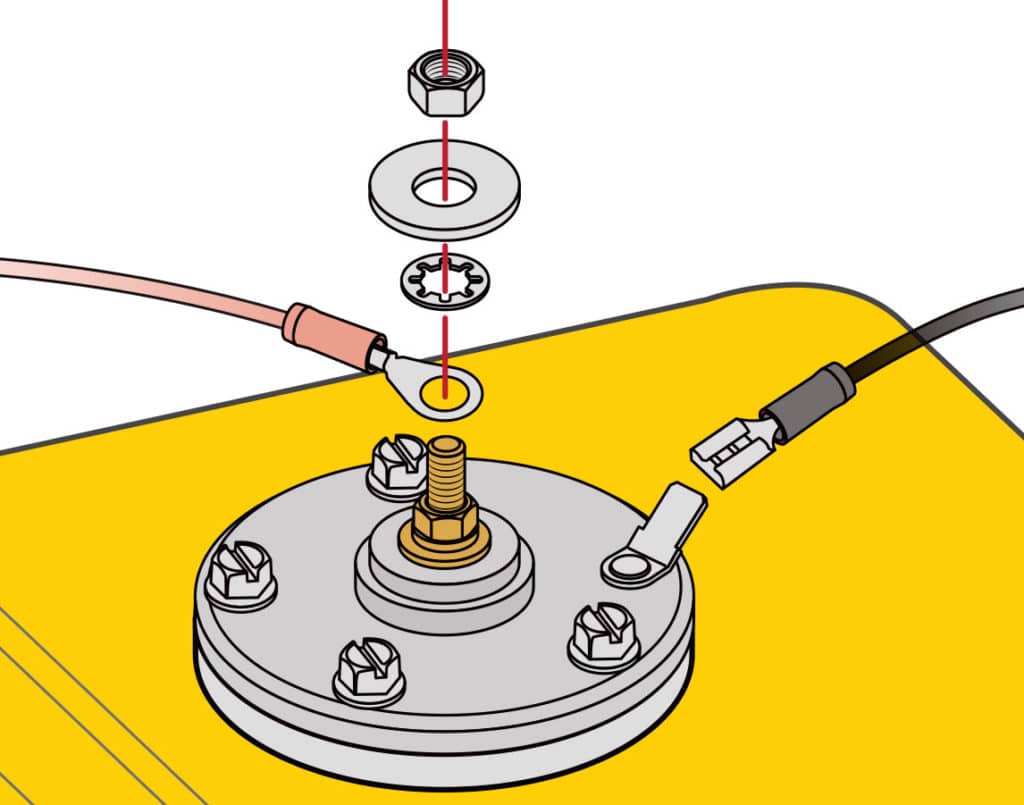
Remember that the sender could be old and the float saturated with fuel. The float arm could be bent or rusted so badly, it’s flexing and giving bad readings. Disconnect the wires, remove the five screws, pull it out and look at it. Replace as needed. Take all precautions against flame and spark when removing a fuel sender.
Replacement
Most fuel gauges are the standard 2 1/8-inch diameter. To replace, disconnect the wiring from the existing gauge and remove the holding bracket using a nut driver or socket. Remove the gauge, install the new gauge, and reconnect the wires.
Read Next: Boat Fuel Tank Vent Tips
The sender is trickier. Your new sender will likely be a universal unit, requiring you to measure your old sender’s length and arc movement, and measure your tank’s depth. Adjusting the sender means carefully cutting the float arm to the correct length for your tank’s depth. Install the new sender in the tank hole with the supplied gasket (no sealant needed). Take a run and check for leaks.
- More: diy projects , How-To
More How To
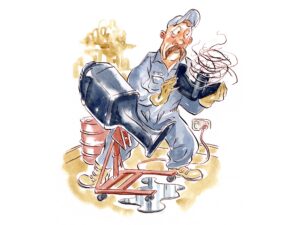
The Key to Successful DIY Maintenance
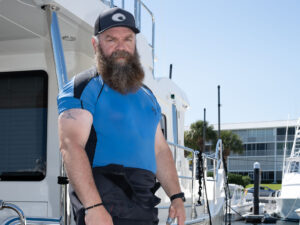
On Board With: Jeremy Dennard
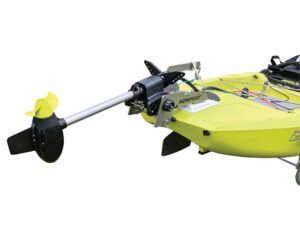
Installing an Electric Motor on a Kayak
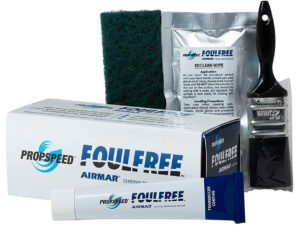
We Test: Foulfree by Propspeed
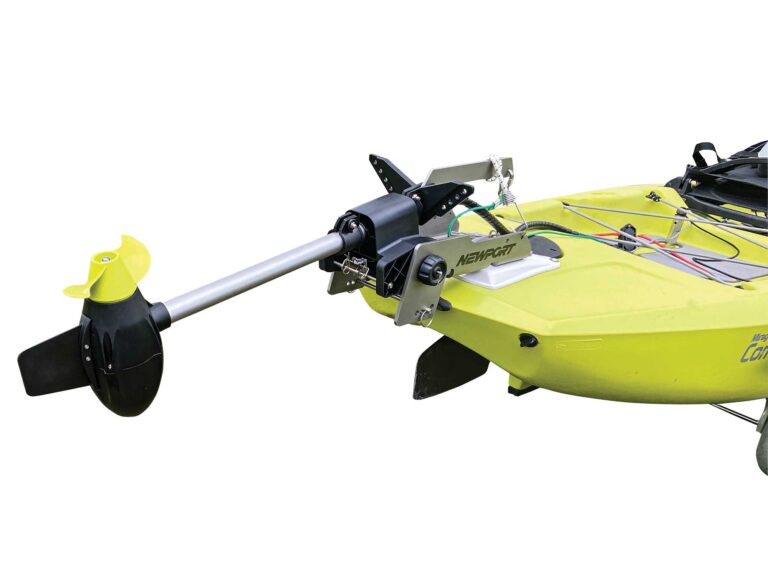
Boat Test: 2024 Formula 457 CCS
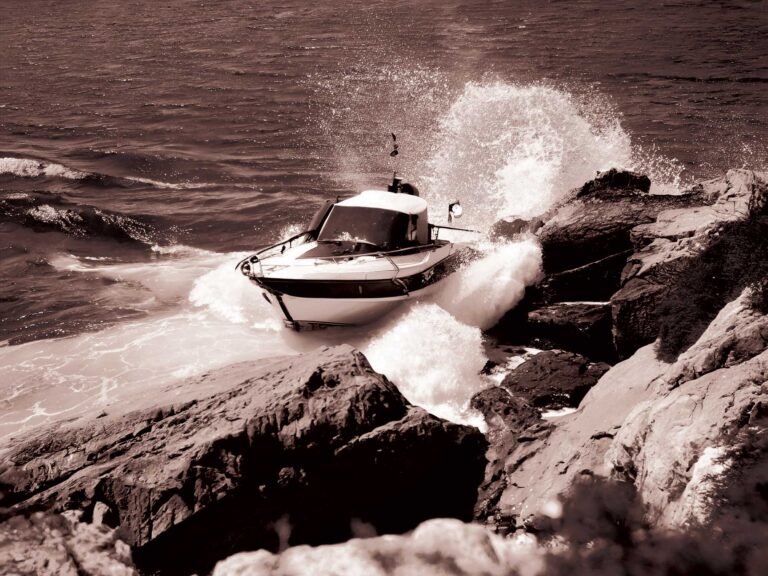
What to Do if Your Boat’s Engine Dies

- Digital Edition
- Customer Service
- Privacy Policy
- Cruising World
- Sailing World
- Salt Water Sportsman
- Sport Fishing
- Wakeboarding
Many products featured on this site were editorially chosen. Boating may receive financial compensation for products purchased through this site.
Copyright © 2024 Boating Firecrown . All rights reserved. Reproduction in whole or in part without permission is prohibited.
- Backing Pads
- Bolts & Fixings
- Bonding Cable
- Bow Thruster Anodes
- Electro Eliminators
- Caterpillar
- Engine Anode Kits
- Volvo Penta
- Galvanic Isolation Blockers
- Ground Plates
- Manicooler Anodes
- Mooring Hanging Anodes
- Zinc Shaft Nuts
- Outdrive Anodes
- Universal Pencil Anodes
- Boat Covers
- Boat Cleaning
- Damp Prevention
- Hand Cleaning
- Spillage Clean-Up
- Toilet Cleaning
- Water Cleaning
- Deck Coverings
- Fuel Treatments
- Gasket Material
- Oils, Greases & Lubricants
- Resins & Fillers
- Sail Protection
- Screen Wash
- Sealants & Adhesives
- Fire Protection Sheets
- Soundproofing Adhesives & Fixings
- Soundproofing Damping Barrier
- Soundproofing Sheets
- Trailer Accessories
- Antennas & Accessories
- Brackets & Hooks
- Cabin Heaters & Accessories
- Cup Holders
- Hatches & Portholes
- Padlocks & Strongboxes
- Signs & Labels
- Table Legs & Bases
- Manual Wipers
- Screen Washing Kits
- Wiper Blades
- Wiper Motors
- Control Units
- Accessories
- Anchor Chain Connectors
- Anchor Chain Markers
- Bow Rollers
- Hawsehole Plates & Pipes
- Windlass Spares
- Barge Poles
- Bollards, Cleats, Eye Plates & Fairleads
- Canopy Fittings
- Cleaning & Protection
- Deck Fillers & Filler Caps
- Deck Plates
- Deck Plugs & Sockets
- Boat Fenders
- Dock and Pontoon Fenders
- Fender Socks
- Fender Locks
- Fender Pumps
- Fender Ropes
- Marker Buoys
- Fishing Rod Holders
- Flags, Poles & Wind Indicators
- Handles & Handrails
- Life Rings & Rescue Lights
- Mooring Equipment
- Radar Reflectors
- Scuppers & Drains
- Steps & Ladders
- Waste Pump Out Deck Fittings
- Accumulator Tanks
- Calorifiers
- Valves & Fittings
- Deck Filler Keys
- Universal Deck Fillers
- Water Deck Fillers
- Water Deck Filler Caps
- Domestic Antifreeze
- Circulation Pumps
- Pressure Pumps
- Transfer Pumps
- Manual Pumps
- Immersion Heaters
- Push-Fit Plumbing Pipe & Fittings
- Taps & Showers
- Water Purifiers & Water Filters
- Water Tanks
- Connection Kits
- Inspection Lids
- Level Gauges
- Level Senders
- Water Treatments
- Flexible Shaft Couplings
- Flexible Shaft Coupling Earthing Connectors
- Flexible Shaft Coupling Spares & Accessories
- Gland Packing
- Packing Removal Tools
- Beneteau & Jeanneau Shaft Bearings
- Brass Shaft Bearings
- GRP Shaft Bearings
- Propeller Shaft Coupling Adaptors
- Solid Bobbin Shaft Couplings
- Solid Shaft Couplings
- Split Half Solid Shaft Couplings
- Propeller Shaft Seals
- Shaft Seal Repair Kits
- Remote Greasers & Cups
- Rope Cutters
- Alarms & Warning Devices
- Battery Boxes
- Battery Cable Terminals
- Battery Combiners
- Battery Connector Leads
- Battery Chargers
- Battery Isolator Switches
- Battery Monitors & Gauges
- Battery Split Chargers
- Battery Terminal Covers
- Isolation Transformers
- Panels & Controls
- Power Inverters
- Voltage Converters
- Cable Connectors & Accessories
- Fuses & Circuit Breakers
- Kettles and Coffee Machines
- Electronic Device Mounts & Accessories
- Accessory Plugs & Sockets
- DIN Plugs & Sockets
- Shore Power Plugs & Sockets
- Busbars / Power Distribution
- Covers & Insulation Disks
- Jump Start Power Connectors
- Power Bushings
- Relays & Solenoids
- Shore Power Connections
- Solar Panels & Accessories
- Switches & Switch Panels
- Voltage Converters & Inverters
- Windscreen Wiper Systems
- Adaptor & Drive Plates
- Crankcase Vent Systems
- Drive Belts
- Engine & Gearbox Oil
- Engine Flushing Valves
- Crankshaft Mounted Cooling Pumps
- Electric Circulation Pumps
- Engine Driven Circulation Pumps
- Pump Pulleys
- Flange Mounted Cooling Pumps
- Fuel Lift Pumps
- Pulley Driven Cooling Pumps
- Exhaust Outlets
- Expansion Tanks
- Flexible Engine Mounts
- Fuel, Air & Oil Filters
- Reconditioned Gearboxes
- Glow & Spark Plugs
- Combined Heat Exchanger & Header Tanks
- Cooling Tubes - Tubestacks
- Engine Mounted Header Tanks
- Filler Necks
- Heat Exchanger Manifolds / Manicoolers
- Intercoolers
- Keel Cooled Manifolds / Manicoolers
- Nuts, Bolts & Washers
- Tubular Heat Exchangers
- Water Cooled Manifolds
- Oil Clean Up Products
- Oil Coolers & Accessories
- Outboard Motor Accessories
- Pressure Caps
- Beta Marine
- BMC, Leyland & Land Rover
- Johnson Evinrude (OMC)
- New Holland Genesis
- Thornycroft
- Volvo Penta Saildrives
- Volvo Penta Sterndrives
- Yanmar Saildrives
- Anti-Siphon Valves
- Check Valves
- Dry Exhaust Bellows
- Dry Exhaust Pipe
- Dry Exhaust Silencers & Accessories
- Cast Exhaust Outlets
- Exhaust Outlet Gaskets
- Multi-Choice Exhaust Flanges
- Multi-Choice Spray Heads
- Wet Exhaust Mixers
- Exhaust Lagging
- Exhaust Outlets & Flaps
- Exhaust Temperature Alarms
- Gas / Water Separators
- Heat Exchanger Filler Necks
- Heat Exchanger Nuts, Bolts & Washers
- Heat Exchanger O-Rings
- Manifold & Exhaust Outlet Gaskets
- Replacement Cooling Tubes (Tubestacks)
- Replacement End Caps
- Inline Mufflers
- Pipe Repair Kits
- Crush Sleeves
- 180 Degree Bends
- Exhaust Elbow Connectors
- Exhaust Hose Reducers
- Rotating Hose Connections
- Straight Exhaust Lengths
- Waterlock Mufflers
- Wet Exhaust Hose
- Brass Fittings
- Bronze Fittings
- DZR Brass Fittings
- Non-Metallic Fittings
- Stainless Steel Fittings
- Blanking Caps
- Compression
- Fitting Kits
- Hose Connectors
- Pipe Manifolds
- Sender Adaptors
- Skin Fittings
- Gas Equipment
- Sealants & Thread Tape
- Strainers & Spares
- Valves & Spares
- Anti Theft Devices
- Copper & Nylon Tubing
- Diesel Deck Fillers
- Diesel Deck Filler Caps
- Petrol Deck Fillers
- Petrol Deck Filler Caps
- Filling Funnels
- Fuel Filters
- Fuel Filter Elements
- Fuel Filter Fittings
- Fuel Filter Spares & Accessories
- Fuel Polishing
- Fuel Primer Pumps
- Fuel Transfer Pumps
Fuel Gauges
Fuel level senders.
- No Smell Fuel Filters & Elements
- Pipe Clips & Copper Saddles
- Fuel Clean Up Products
- Fuel Line Anti-Spill Devices
- Jerry Cans & Portable Fuel Tanks
- Fuel Tank Fittings
- Water Detection Alarms
- Kettles and Coffee Makers
- Cookers, Hobs & Sinks
- Electric Water Circulation Pumps
- Electric Water Pressure Pumps
- Electric Water Transfer Pumps
- Manual Water Pumps
- Fire Extinguishers
- Refrigerators, Freezers & Cool Boxes
- Bulbs & Accessories
- Electrical Cables
- Ammeter Gauges
- Battery Condition Gauges
- Blank Gauges
- Clock Gauges
- Combination Gauges
- Compass Gauges
- Depth Sounders
- Fuel Level Gauges
- Hourmeter Gauges
- Inclinometer Gauges
- Oil Pressure Gauges
- Outboard Temperature Gauges
- Rudder Angle Gauges
- Speedometer Gauges
- Synchroniser Gauges
- Tachometer Gauges
- Trim Level Gauges
- Turbo & Vacuum Gauges
- Voltmeter Gauges
- Warning Gauges
- Waste Water Level Gauges
- Water Level Gauges
- Water Pressure Gauges
- Water Temperature Gauges
- Gauge Voltage Converters
- Instrument Panels & Wiring Looms
- Depth Senders
- Fittings For Senders
- Oil Pressure Alarm Switches
- Oil Pressure Senders
- Pitot Speedometer Senders
- Resistance Exchangers
- Rudder Angle Senders
- Tachometer Senders
- Temperature Alarm Switches
- Temperature Senders
- Switch Panels
- Coolant & Heater Hose
- Deckwash Hose
- Ducting Hose
- Exhaust Hose
- Fresh Water Food Quality Plumbing Hose
- General Purpose Hose
- Hose & Pipe Repair Kits
- Clamp-Aid Hose Clips Guards
- Clipdrivers For Clips & Clamps
- Jubilee Hose Clips
- Jubilee High Torque Clips
- Jubilee Superclamps
- Hydraulic Oil Cooler Pipes
- Layflat Hose
- Sanitation & Waste Hose
- Hose Elbows
- Reducing Hose Elbows
- Reducing Straight Hose
- Specially Shaped Hose
- Straight Hose Lengths
- Steering Hose
- Water Intake Hose
- BA15s Bulbs
- BA15d Bulbs
- BAY15d Bulbs
- Festoon Bulbs
- Fluorescent & Halogen Tubes
- Right Angle Prefocus Bulbs (Golight Bulbs)
- Screw In Bulbs
- Sealed Beam Bulbs
- Wedge Base Bulbs
- Chart, Map & Reading Lights
- Deck Lights
- Floodlights
- Interior Lights
- Spares & Accessories
- Navigation Lights
- Pole Lights
- Rescue Lights
- Searchlights & Spotlights
- Underwater Lights
- Utility & Courtesy Lights
- Warning Lights
- Antifouling Paint
- Bilge & Locker Paint
- Blacking Paint
- Engine Paint
- Paint Brushes and Accessories
- Protective Coatings
- Rust Inhibitors
- Surface Preparation & Finishes
- Thinners, Degreasers & Strippers
- Topcoat / Flowcoat
- Topcoat Primers
- Underwater Primer
- Submersible Bilge Pumps
- Electric Motor Bilge Pumps
- Clutched Bilge Pumps
- Manual Bilge Pumps
- Bilge Pump Panels & Switches
- Bilge Water Level Alarms
- Bilge Pump Spares & Accessories
- Bilge Filters, Elements & Cleaners
- Strum Boxes
- Clutch Pumps
- Domestic Water Pumps
- Drill Pumps
- Crankshaft Mounted Engine Cooling Pumps
- Engine Pump Pulleys
- Flange Mounted Engine Cooling Pumps
- Pulley Driven Engine Cooling Pumps
- Impeller Pullers & Lubricant
- Livewell Pumps
- Macerator Pumps
- Sump and Oil Change Pumps
- Washdown Pumps
- Waste Pumps
- Bungee Cords
- Beacons & Transponders
- Battery Isolators
- Bilge Pump Filters
- Circuit Breakers
- Deck Fillers with Labels Engraved
- Diesel, Fuel & Gas Shut Off Labels
- Electrical Cable
- Engine Mounts
- Fuel Fittings, Valves & Cocks
- Fuel Hose (ISO 7840)
- Fuel Tank Vents and Plugs
- Shore Power Cable
- Terminal Covers
- Ventilation
- Emergency Ladders
- Fire & Smoke Alarms
- Hi-Vis Bags
- Kill Switches
- Life Jackets
- Buoyancy Aids
- Accessories & Spares
- Pet Buoyancy Aids
- Safety Plugs
- Searchlights
- No Smell Waste Filters & Elements
- Shower Sump Systems
- Plugs & Chains
- Toilet Spares
- Waste Water Tanks
- Extraction Pipes
- Odour Treatments
- Vacuum Valves
- Bow & Stern Thrusters
- 33C Fitting Control Cables
- 43C Fitting Control Cables
- Control Cable Fittings
- Industrial Control Cables (33C Fitting)
- UD617 Control Cables
- Dual Station Control Units
- Control Levers
- Helms & Bezels
- Outboard Engine Tie Bars
- Rudders, Glands & Tiller Arms
- Steering Wheels
- Actuators & Brackets
- Control Panels
- Clamshell Vents
- Dorade Boxes
- Extractor Fans
- Inline Blowers
- Mushroom Deck Vents
- Snail Cam Blowers
- Aqua Signal
- ASAP Electrical
- Faria Beede
- R&D Marine
- Engine Anodes
- Hull Anodes
- Propeller Shaft Anodes
- Soundproofing
- Latches, Locks & Stoppers
- Anchors & Accessories
- Fenders & Accessories
- Calorifiers (Water Heaters) & Fittings
- Deck Fillers & Caps
- Water Tank Accessories
- Flexible Couplings
- Gland Packing & Removal Tools
- Propeller Shaft Bearings
- Propeller Shaft Couplings
- Batteries & Accessories
- Plugs & Sockets
- Power Distribution
- Engine Pumps
- Gearboxes, Spares & Accessories
- Heat Exchangers & Exhaust Manifolds
- Engine Exhaust Outlets
- Tubes, Fittings & Hose Connectors
- Fillers & Filler Caps
- Filters, Elements & Spares
Gauges & Senders
- Spill Prevention & Clean-Up
- Tanks & Accessories
- Gauges & Instruments
- Senders & Fittings
- Hose Clips, Clamps & Accessories
- Silicone Hose
- Bulbs & Tubes
- Interior Lights & Spares
- Navigation Lights & Spares
- Searchlights & Spares
- Bilge Pumps
- Engine Cooling Pumps
- Pump Spares
- Life Jackets & Buoyancy Aids
- Sink & Shower Waste Outlets
- Waste Water Tank Accessories
- Control Cables & Fittings
- Engine & Gearbox Controls & Spares
- Engine Stop Cables & Fittings
- Hydraulic Steering
- Mechanical Steering
- Trim Tabs & Accessories
Live Stock Figures
Free UK Delivery orders over £120 (inc vat) orders over £100 (ex vat)
Same Day Dispatch order by 3:30pm
Technical Help & Advice
Our range of marine fuel gauges and fuel level senders are designed to reliably monitor and display the fuel level in your boat, whilst adding a stylish fuel gauge to match your dashboard. We supply boat fuel gauges from Faria Beede and Vetus suitable for 12 volt and 24 volt electrical systems. Different kinds of fuel level senders are available, including dip type level senders and float arm level senders. You should always be aware of how much fuel you have when route planning. With such an important marine system, it is vital to be fully informed.
Our range of marine fuel gauges and fuel level senders are designed to reliably monitor and display the fuel level in your boat, whilst adding a stylish fuel gauge to match your dashboard. We supply boat fuel gauges from Faria Beede and Vetus suitable for 12 volt and 24 volt electrical systems. Different kinds of fuel level senders are available, including dip type level senders and float arm level...
Get offers in your inbox
Sign up for the latest offers, product news, technical advice and more.
By submitting your details you consent to our Privacy Notice .
This site is protected by reCAPTCHA and the Google Privacy Policy and Terms of Service apply.
JavaScript seems to be disabled in your browser. For the best experience on our site, be sure to turn on Javascript in your browser.
We ship worldwide
- Testimonial
- Create an Account
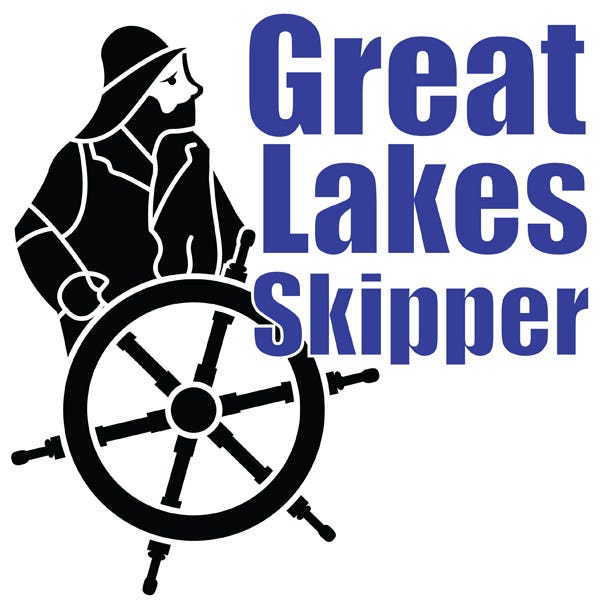

Boat Fuel Gauges
Don't let a faulty fuel gauge spoil a day on the water. Get boat gas gauges at closeout prices from Great Lakes Skipper. We have dozens of marine fuel gauges, both digital fuel gauges and analog gas gauges, in all sizes and colors. Check our selection of boat fuel gauges from brands like Livorsi, Teleflex, Faria, Beede, and more. You'll love our huge inventory, and our amazing discount prices. Shop online or order over the phone - we're here to help.
Shop Products
Items 1 - 12 of 118
- You're currently reading page 1

- Privacy Policy
- Terms of Use
How to Read the Fuel Gauge on Boats: Troubleshoot Guide
Understanding how to read the fuel gauge on a boat is essential for every boater. It allows you to monitor your fuel levels accurately and ensures that you have enough fuel for your journey.
By properly reading the fuel gauge, you can plan your trips accordingly and avoid unexpected fuel shortages. In this article, we will provide a comprehensive guide on how to read the fuel gauge on boats, covering the different types of fuel gauges, interpreting the readings, and tips for accurate fuel level monitoring.
Whether you’re a seasoned boater or a beginner, this guide will help you navigate the waters with confidence and peace of mind.
What is the purpose and function of the fuel gauge on boats?
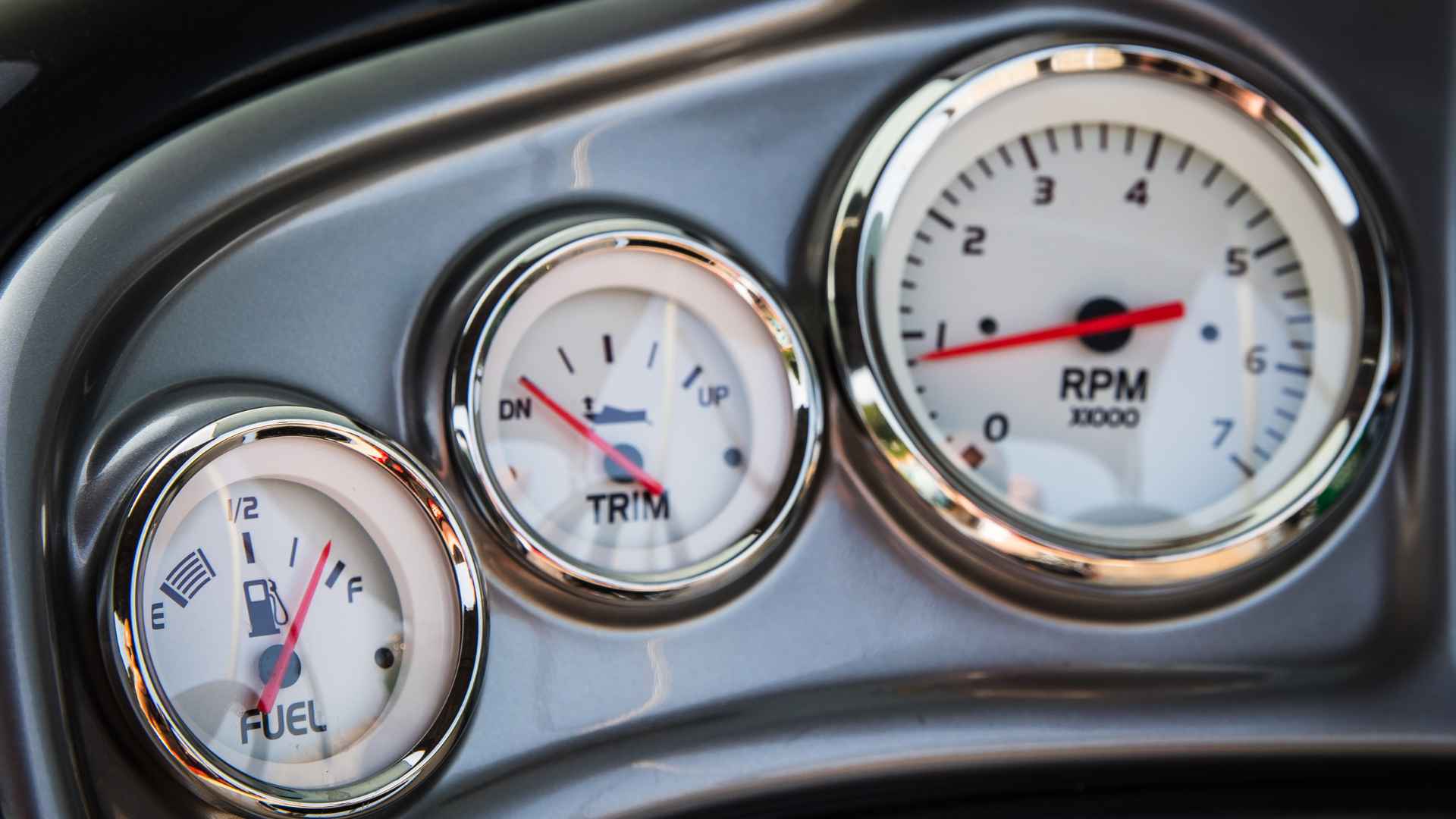
The fuel gauge on boats serves a crucial role in providing a visual representation of the fuel level in the boat’s fuel tank. It allows boaters to monitor the amount of fuel remaining, ensuring efficient trip planning and avoiding fuel-related issues.
The fuel gauge typically consists of a display or indicator on the boat’s dashboard that shows the fuel level. This display can be in the form of an analog gauge with a needle or a digital display with numeric values or bars.
The primary function of the fuel gauge is to provide boaters with an estimation of how much fuel is available. This information is vital for planning trips and ensuring that there is sufficient fuel for the intended duration of the journey. It helps boaters avoid the risk of running out of fuel in the middle of the water, which can be not only inconvenient but also dangerous.
Accurate fuel level readings are essential for making informed decisions about refueling. By knowing the fuel level, boaters can plan refueling stops at suitable locations and avoid running out of fuel in remote or inaccessible areas.
Moreover, the fuel gauge provides an early warning system for potential fuel-related issues. A sudden drop in the fuel level, inconsistent readings, or erratic behavior of the gauge may indicate a problem with the fuel system, such as a malfunctioning fuel pump or a fuel leak. Regularly monitoring the fuel gauge allows boaters to identify these issues early on and take appropriate action to ensure safety and prevent further damage.
In summary, the fuel gauge on boats serves the vital purpose of providing a visual representation of the fuel level in the boat’s fuel tank. It helps boaters plan their trips efficiently, avoid running out of fuel, and detect potential fuel system issues.
What are the different types of fuel gauges commonly found on boats?
Fuel gauges on boats come in different types, each with its own characteristics and ways of displaying fuel levels. The two most common types of fuel gauges are analog gauges and digital gauges.
1. Analog Gauges:
Analog gauges use a needle to indicate the fuel level on a dial or scale. The needle moves along the scale, indicating the amount of fuel remaining in the tank. These gauges are typically found in older boats and have been a traditional method of displaying fuel levels. The needle usually points to “Full” when the tank is completely filled and moves towards “Empty” as the fuel level decreases.
- Familiarity: Many boaters are accustomed to analog gauges and find them intuitive to read.
- Quick Glance: Analog gauges provide a quick visual reference of the fuel level without needing to interpret numeric values or bar displays.
- Durability: Analog gauges are generally robust and less prone to malfunctions or electronic failures.
- Precision: Analog gauges may not provide precise readings, especially when the fuel level is in between the marked increments on the dial.
- Calibration Issues: Over time, analog gauges can become less accurate due to wear or calibration drift.
- Sensitivity to Sloshing: The movement of fuel within the tank during boat maneuvers can cause the needle to fluctuate, making it more challenging to determine the exact fuel level.
2. Digital Gauges:
Digital gauges use numeric or bar display to show the fuel level in a more precise manner. Numeric displays provide an exact numerical reading of the fuel level, while bar displays use bars to indicate the remaining fuel.
- Accuracy: Digital gauges offer more precise readings, allowing boaters to have a better understanding of the actual fuel level.
- Additional Information: Some digital gauges provide extra features like fuel consumption rate, distance to empty, or fuel flow data, which can be helpful for planning and managing fuel usage.
- Customization: Digital gauges often allow customization of the display format, units, and additional data parameters, providing flexibility to suit individual preferences.
- Learning Curve: Digital gauges may require some time and familiarity to understand the display format and navigate through different menus or settings.
- Potential for Malfunctions: Digital gauges rely on electronic components, and malfunctions or software glitches can occur, leading to inaccurate readings or system failures.
- Cost: Digital gauges are generally more expensive than analog gauges, especially if advanced features or integration with other systems are included.
Remember, regardless of the type of fuel gauge, it’s important to regularly calibrate and maintain the gauge, and to cross-reference the readings with other indicators or measurements for the most accurate assessment of fuel levels on your boat.
Interpreting Analog Fuel Gauges
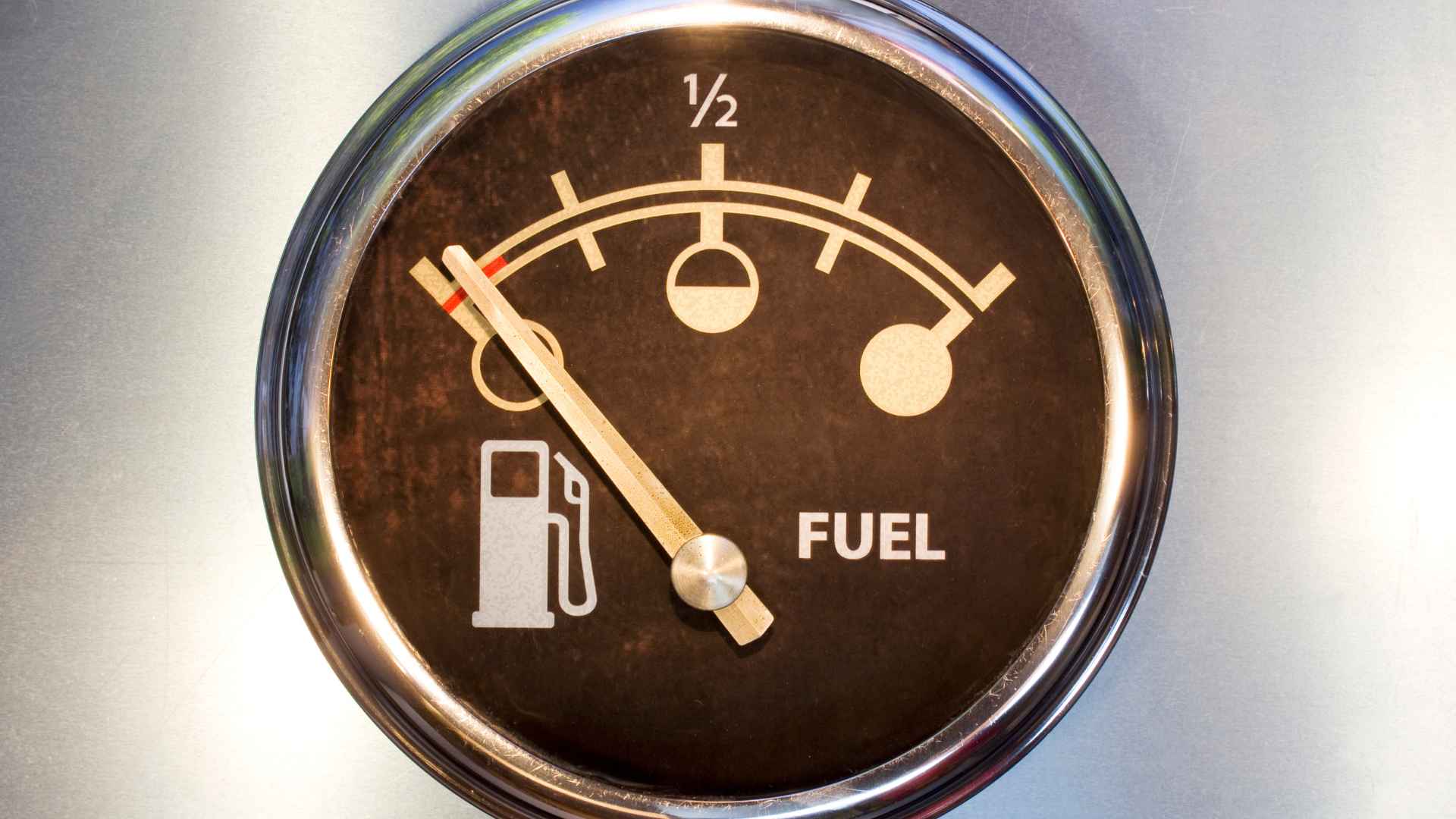
Interpreting analog fuel gauges requires understanding the symbols and markers on the gauge and how they correspond to the fuel level.
Here’s a guide to help you interpret analog fuel gauges:
- Full and Empty Symbols: Most analog fuel gauges have symbols indicating “F” for full and “E” for empty. The needle should align with one of these symbols when the tank is at its respective capacity.
- Markers or Incremental Lines: Analog fuel gauges typically have markers or incremental lines on the scale representing different fuel levels. These lines may be labeled with fractions or percentages (e.g., 1/4, 1/2, 3/4) or simply represented by lines without specific labeling.
- Needle Position: The position of the needle relative to the markers or symbols indicates the current fuel level. As the fuel level decreases, the needle moves towards the “E” symbol. Conversely, as the fuel level increases, the needle moves towards the “F” symbol.
- Intermediate Readings: Analog fuel gauges may have additional markers or lines between the major markers. These intermediate readings help provide a more precise estimation of the fuel level. Estimate the fuel level based on the position of the needle in relation to these intermediate markers.
- Accuracy Considerations: Keep in mind that analog fuel gauges may have limitations in precision. Due to variations in gauge calibration and fuel sloshing within the tank during boat movements, the needle’s position may not always be an exact representation of the fuel level. It’s essential to consider these factors when interpreting analog fuel gauges.
Remember, each boat may have slight variations in gauge design, so it’s recommended to refer to the manufacturer’s instructions or consult your boat’s owner’s manual for specific details on interpreting the analog fuel gauge. Additionally, it’s a good practice to cross-reference the fuel gauge reading with other indicators, such as a fuel flow meter or manually measuring the fuel level in the tank, for a more accurate assessment of the fuel quantity.
Interpreting Digital Fuel Gauges
Interpreting digital fuel gauges is straightforward, as they provide precise numeric values or bar graphs to indicate the fuel level.
Here’s a guide to help you interpret digital fuel gauges:
- Numeric Display: Digital fuel gauges present the fuel level as a specific numeric value, such as the remaining gallons, liters, or a percentage of the tank’s capacity. Simply read the displayed number to determine the current fuel level.
- Bar Graph Representation: Some digital fuel gauges use a bar graph or progress bar to represent the fuel level visually. The bar starts at one end (typically empty) and progresses towards the other end (typically full) as the fuel level increases. By observing the position of the bar within the graph, you can estimate the fuel level.
- Warning or Low Fuel Indicators: Digital fuel gauges may also include warning or low fuel indicators. These indicators often appear when the fuel level reaches a predefined threshold, alerting you to the need for refueling. Pay attention to these indicators to ensure you have sufficient fuel for your boating activities.
- Calibration and Accuracy: Digital fuel gauges are generally more accurate than analog gauges. However, it’s essential to ensure the gauge is properly calibrated for accurate readings. If you suspect any inaccuracies, consult your boat’s owner’s manual or contact the manufacturer for calibration instructions.
Remember to regularly check and calibrate your digital fuel gauge to ensure its accuracy. Additionally, it’s always a good practice to cross-reference the digital fuel gauge reading with other indicators or manual measurements to verify the fuel level. This will help you maintain an accurate understanding of the fuel quantity on your boat.
Factors That Can Affect the Accuracy of Fuel Gauge Readings.

Several factors can affect the accuracy of fuel gauge readings on boats. It’s important to be aware of these factors to avoid misinterpretation. Here are some factors that can impact fuel gauge accuracy:
- Boat Trim: The trim or angle at which the boat sits in the water can affect fuel gauge readings. If the boat is tilted significantly forward or backward, the fuel may not distribute evenly across the tank, leading to inaccurate readings. It’s important to ensure the boat is properly trimmed for accurate fuel level indications.
- Rough Waters: When boating in rough or choppy waters, the fuel inside the tank can slosh around, causing temporary fluctuations in the fuel gauge readings. This is particularly common in boats with larger fuel tanks. It’s advisable to consider these fluctuations as temporary and not indicative of actual fuel consumption.
- Sloshing Fuel: Fuel tanks are designed with baffles or anti-sloshing mechanisms to minimize fuel movement within the tank. However, under certain conditions, such as sudden acceleration, deceleration, or sharp turns, fuel can still slosh inside the tank. This movement can temporarily affect the fuel gauge readings. It’s important to be aware of this potential fluctuation and consider it when interpreting the fuel gauge.
- Calibration: Fuel gauges require periodic calibration to maintain accuracy. Over time, factors like sensor drift or changes in the fuel tank’s shape and dimensions can affect the gauge’s accuracy. If you notice persistent inaccuracies or irregularities in the fuel gauge readings, it may be necessary to calibrate or recalibrate the fuel gauge system. Refer to your boat’s owner’s manual or consult a professional for proper calibration procedures.
- Electrical Issues: Electrical problems, such as loose connections or faulty wiring, can also impact the accuracy of fuel gauge readings. If you suspect an electrical issue, it’s important to inspect the wiring, connections, and gauge itself to ensure they are in good working condition.
While fuel gauges are designed to provide accurate readings, it’s important to consider these factors and exercise caution when interpreting the readings. It’s always a good practice to cross-reference the fuel gauge reading with manual measurements or other indicators to ensure a reliable estimate of the fuel level in your boat’s tank.
Importance of Monitoring Fuel Consumption in Addition to Reading the Fuel Gauge.
Monitoring fuel consumption is an essential practice in addition to reading the fuel gauge on your boat. While the fuel gauge provides a real-time indication of the remaining fuel level, tracking fuel consumption offers several benefits:
- Estimating Range: By monitoring fuel consumption, you can estimate how far you can travel with the current fuel level. This allows you to plan your trips more effectively, especially when boating in remote areas or on long journeys where refueling options may be limited.
- Planning Refueling Stops: Knowing your boat’s average fuel consumption rate helps you plan refueling stops strategically. This is particularly important during extended trips or when navigating unfamiliar waters. By keeping track of fuel consumption, you can identify optimal refueling locations and ensure you don’t run out of fuel.
- Identifying Fuel System Issues: Monitoring fuel consumption can also help detect potential issues with your boat’s fuel system. A sudden increase in fuel consumption may indicate a fuel leak, a clogged filter, or an inefficient engine. By observing any unusual changes in fuel consumption, you can address these issues promptly and avoid more significant problems down the line.
There are several tools and techniques you can use to monitor fuel consumption:
- Fuel Log: Keeping a log of your fuel usage is a simple and effective method. Note the starting fuel level, time, and distance at the beginning of each trip, and record the fuel level again at the end. By tracking the distance traveled and the amount of fuel consumed, you can calculate your boat’s average fuel consumption rate.
- Fuel Flow Meters: Installing a fuel flow meter provides real-time data on fuel consumption. These devices measure the rate of fuel flowing through the system and display it on a digital screen. Fuel flow meters offer accurate and instantaneous readings, allowing you to monitor consumption more precisely.
- Onboard Computer Systems: Some modern boats come equipped with onboard computer systems that provide comprehensive data, including fuel consumption. These systems use sensors and algorithms to calculate fuel consumption based on engine performance and other variables. Consult your boat’s manual or the manufacturer to understand how to access and interpret this information.
By monitoring fuel consumption, you can better manage your boat’s fuel usage, optimize your trips, and detect any fuel-related issues early on. It is an important practice that complements reading the fuel gauge and ensures a smoother and more efficient boating experience.
Importance of Calibrating and Maintaining the Boat’s Fuel Gauge System.
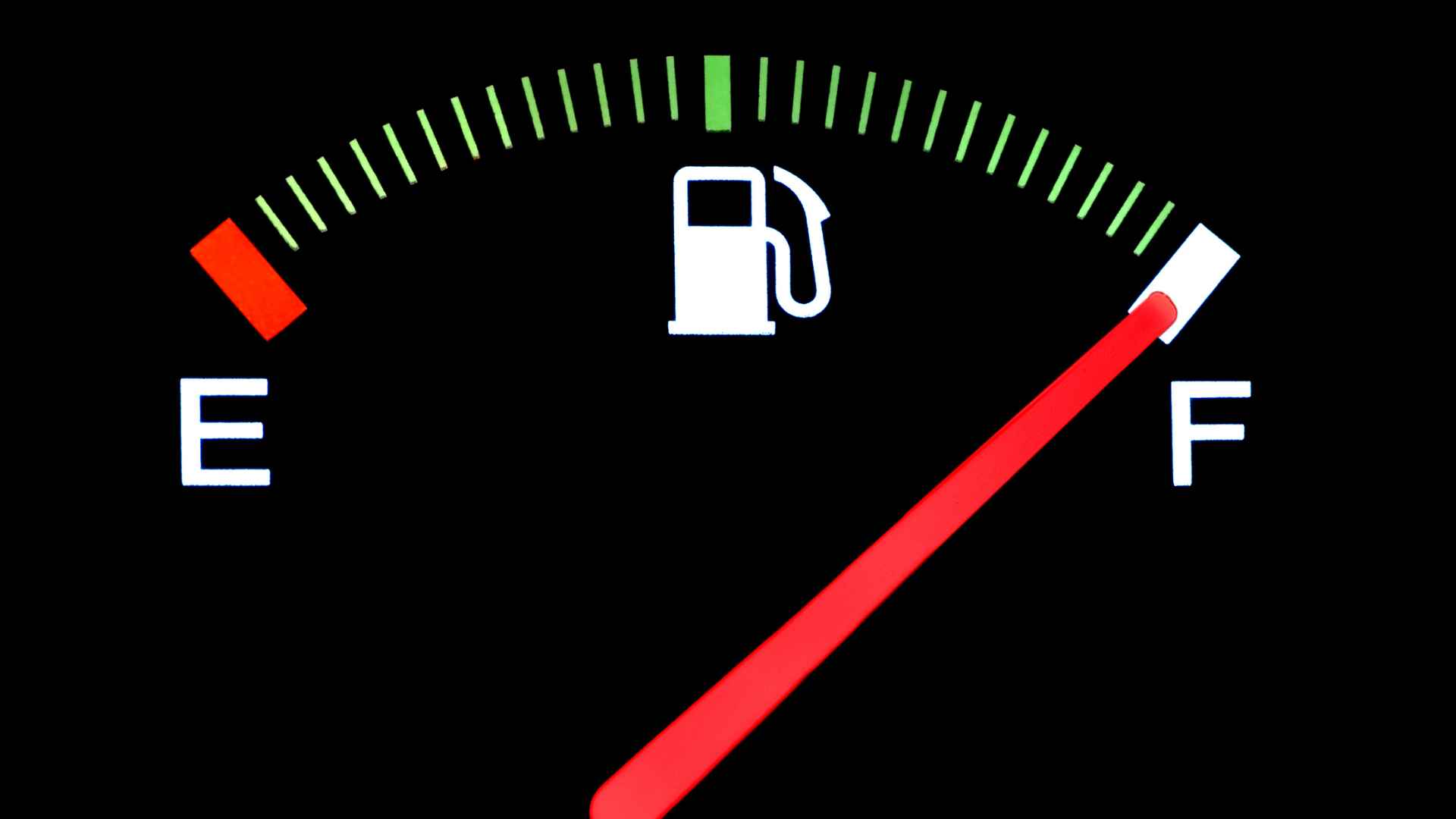
Calibrating and maintaining your boat’s fuel gauge system is crucial to ensure accurate readings and reliable fuel level information. Over time, factors such as wear and tear, electrical fluctuations, or changes in the sender unit’s performance can affect the gauge’s accuracy. Here are some key points to consider:
- Calibration Importance: Calibration involves adjusting the fuel gauge system to accurately reflect the actual fuel level in the tank. Regular calibration helps maintain the gauge’s accuracy, providing you with reliable information about your fuel consumption and remaining fuel. It is particularly important if you notice significant discrepancies between the fuel gauge reading and actual fuel levels.
- Calibration Techniques: Calibration methods may vary depending on the type of fuel gauge and the specific boat model. Consult your boat’s manual or contact the manufacturer for precise calibration instructions. Typically, calibration involves filling the tank to a known level and adjusting the gauge accordingly. Some boats may have digital calibration menus accessible through onboard computer systems.
- Proper Maintenance: Proper maintenance of the fuel gauge system is essential for accurate readings. Regularly inspect the wiring connections and ensure they are secure and free from corrosion or damage. Check the sender unit, which measures the fuel level, for any signs of wear, debris, or malfunctions. Cleaning the sender unit and ensuring it moves freely can help maintain accurate readings.
- Seek Professional Assistance: If you are unsure about calibrating or maintaining your boat’s fuel gauge system, it is advisable to seek professional assistance. Certified marine technicians or electricians have the expertise and tools to diagnose and calibrate the system accurately. They can also inspect the wiring, sender unit, and other components to identify any potential issues and provide the necessary repairs or replacements.
Regular calibration and maintenance of your boat’s fuel gauge system not only ensure accurate fuel level readings but also contribute to overall safety and peace of mind while boating. By taking proactive steps to keep your fuel gauge system in optimal condition, you can trust the readings and make informed decisions regarding fuel management during your boating adventures.
Watch Marine gas gauge testing | Video
Top 5 FAQs and answers related to How to read the fuel gauge on boats
How can i determine the accuracy of my boat’s fuel gauge .
To determine the accuracy of your boat’s fuel gauge, it is recommended to calibrate it periodically. Fill your fuel tank to a known level and compare it with the gauge reading. If there is a significant difference, consider calibrating the gauge or seeking professional assistance.
What should I do if my boat’s fuel gauge is not reading accurately?
If your boat’s fuel gauge is not reading accurately, first check the wiring connections and the sender unit for any loose or damaged components. Ensure proper calibration, and if the issue persists, it is advisable to consult a marine technician or electrician for further diagnosis and repair.
Can the fuel gauge be affected by boat trim or rough waters?
Yes, boat trim and rough waters can affect the fuel gauge readings temporarily. When the boat is tilted due to trim or experiencing rough waters, the fuel may slosh in the tank, leading to fluctuations in the gauge reading. It’s important to consider these factors and interpret the gauge readings accordingly.
Should I rely solely on the fuel gauge to monitor my fuel levels?
It is recommended to use the fuel gauge as a primary indicator of fuel levels, but it is also important to monitor fuel consumption and plan refueling stops accordingly. Keep track of your fuel consumption using logs or fuel flow meters to estimate range and detect any unusual changes in fuel consumption.
How often should I calibrate my boat’s fuel gauge?
The frequency of calibrating your boat’s fuel gauge depends on various factors, including the type of boat, usage patterns, and manufacturer recommendations. As a general guideline, it is advisable to calibrate the fuel gauge at least once a season or whenever you notice significant discrepancies between the gauge reading and actual fuel levels.

In conclusion, understanding how to read the fuel gauge on boats is essential for safe and efficient boating. Here are the key points to remember:
- Familiarize yourself with the type of fuel gauge on your boat, whether it’s an analog or digital gauge, and understand its specific features and symbols.
- Interpret analog fuel gauges by observing the position of the needle relative to the scale and markers, such as “F” for full and “E” for empty.
- Read digital fuel gauges by understanding the numeric display or bar graph representation to determine the fuel level accurately.
- Consider factors that may affect fuel gauge accuracy, such as boat trim, rough waters, or sloshing fuel in the tank, and interpret the gauge readings accordingly.
- Monitor fuel consumption in addition to reading the fuel gauge to estimate range, plan refueling stops, and detect potential fuel system issues.
- Regularly calibrate the fuel gauge to ensure accurate readings. Consult your boat’s manual for specific calibration techniques and frequency recommendations.
- Perform proper maintenance, including checking wiring connections and the sender unit, to maintain the accuracy of the fuel gauge.
By following these guidelines, boaters can effectively monitor fuel levels, plan their trips accordingly, and enjoy a safe and uninterrupted boating experience. Remember, if you have any specific concerns or questions about your boat’s fuel gauge, consult your boat’s manual or seek professional assistance for accurate guidance.
Share How to Read the Fuel Gauge on Boats: Troubleshoot Guide with your friends and Leave a comment below with your thoughts.
Read The Advantages of Aluminum Pontoon Decking: A Complete Guide until we meet in the next article.
Similar Posts
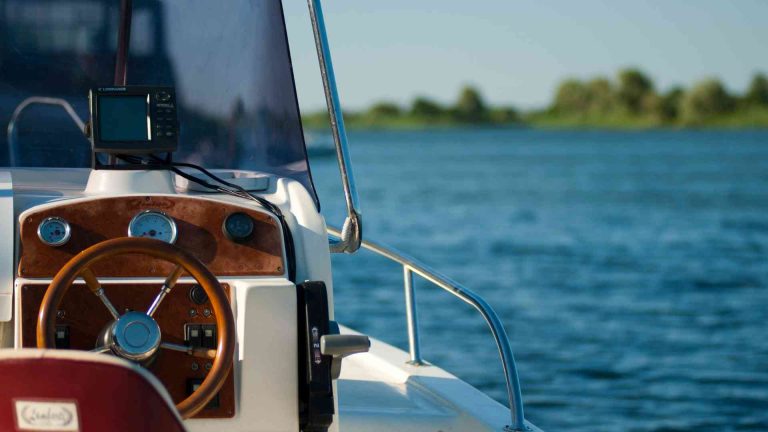
Can Animals Attack Boats? Exploring Water Wildlife
Picture yourself gliding across serene waters, the gentle hum of the boat’s engine your only companion. As you embark on this aquatic adventure, you’re not alone—wildlife often shares the vast expanse of our planet’s oceans and waterways. Perhaps it’s a pod of dolphins dancing in the boat’s wake or a curious seal popping up to…
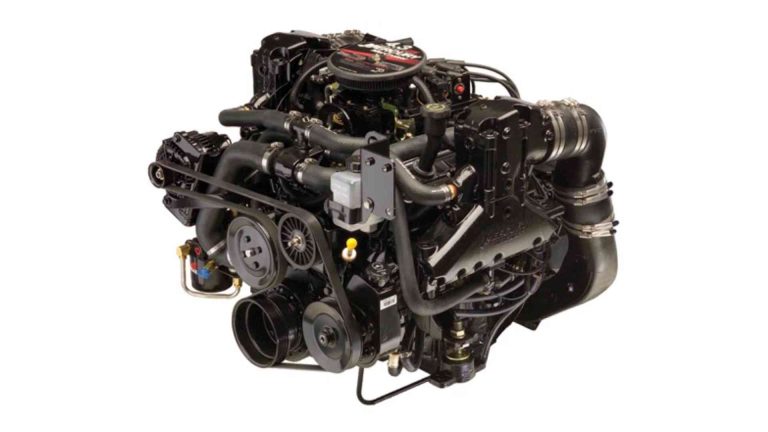
Mercruiser 4.3 Common Problems: Diagnosis and Solutions
Picture this: a beautiful day on the water, the sun shining, and the gentle hum of your boat’s Mercruiser 4.3 engine as you glide across the waves. It’s the quintessential boating experience, but even the most reliable engines can encounter hiccups along the way. The Mercruiser 4.3 engine is a beloved workhorse in the boating…
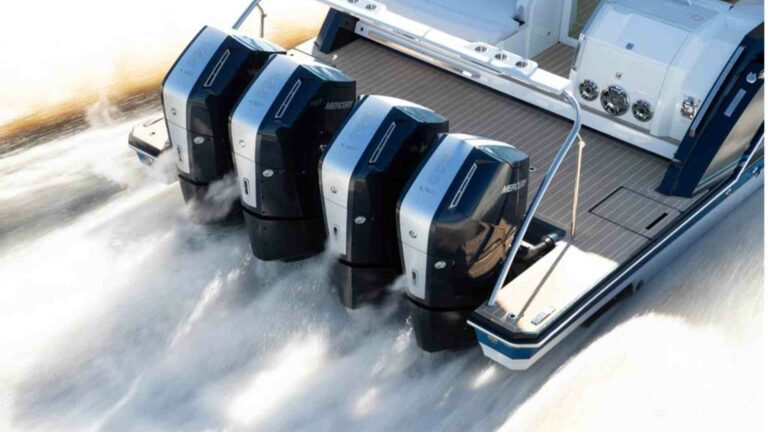
5 Symptoms of a Bad Ignition Sensor on a Mercruiser Outboard
Your trusty Mercruiser roars to life, but something feels off. It sputters, coughs, throws error codes, and leaves you staring longingly at a distant shore. Could it be a faulty ignition sensor? Before you get stranded, learn the telltale signs and keep your boating adventures running smoothly. The Ignition Sensor: Spark Plug Whisperer Think of…
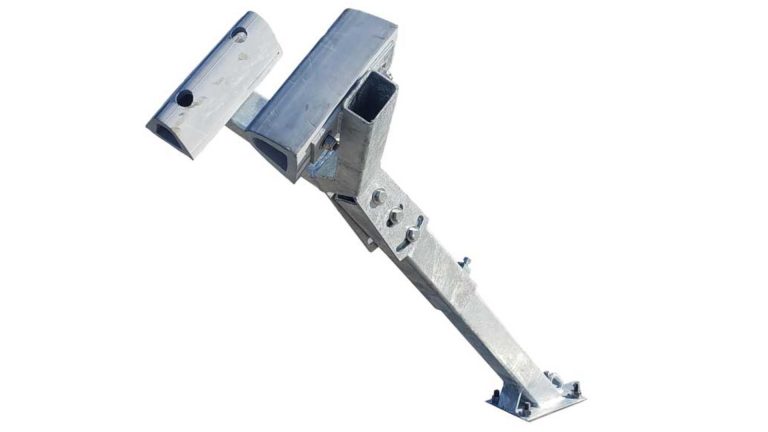
Bow Rest for Boat Trailers: Your Ultimate Guide
A reliable bow rest is not just an accessory; it’s a guardian of your boat’s safety during its land-bound journeys on a trailer. This article dives into the world of bow rests, shedding light on their pivotal role in securing your boat and ensuring safe transport. Welcome to your comprehensive guide on bow rests for…
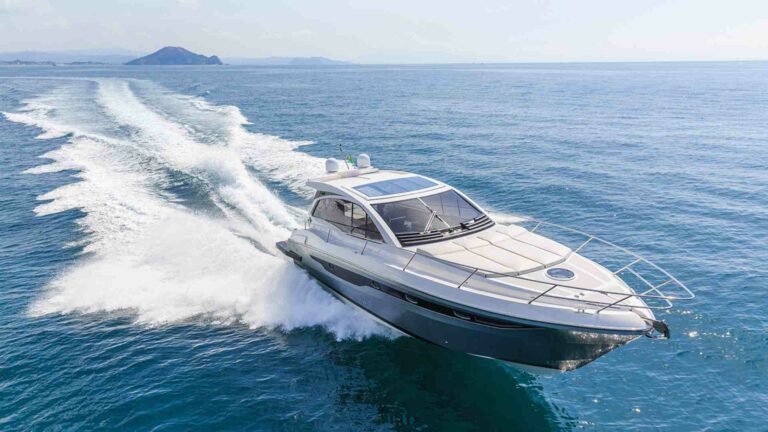
Guide to Boat Insurance Online Quotes
Whether you’re a seasoned sailor or a weekend boater, protecting your investment with boat insurance is essential. But with so many options available, obtaining quotes can feel overwhelming. Fortunately, the internet has revolutionized the way we access information, and getting a boat insurance online quote is now easier than ever. Why Consider Online Quotes: Essential…

How Fast Are Speed Boats: Speed Boating Performance Guide
Speed boats, with their sleek design and powerful engines, evoke a sense of exhilaration and adventure on the water. From racing boats to luxury cruisers, these watercraft come in various shapes and sizes, each engineered for specific performance levels. If you’ve ever wondered just how fast speed boats can go and what factors influence their…

FUEL LEVEL GAUGES
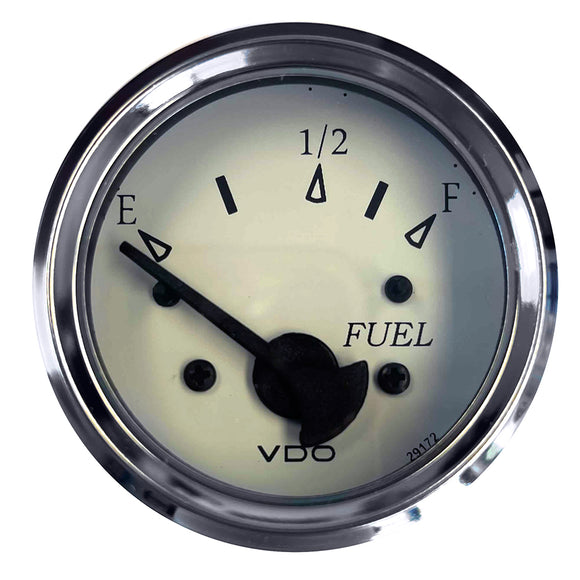
VDO Cockpit Marine 52MM (2-1/16") Fuel Level Gauge - White Dial/Chrome Bezel [301-15278]
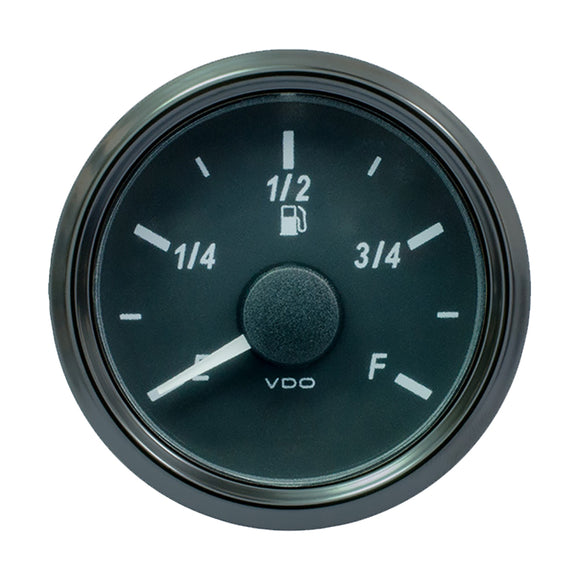
VDO SingleViu 52MM (2-1/16") Fuel Level Gauge - E/F Scale - 90-5 Ohm [A2C3833150030]
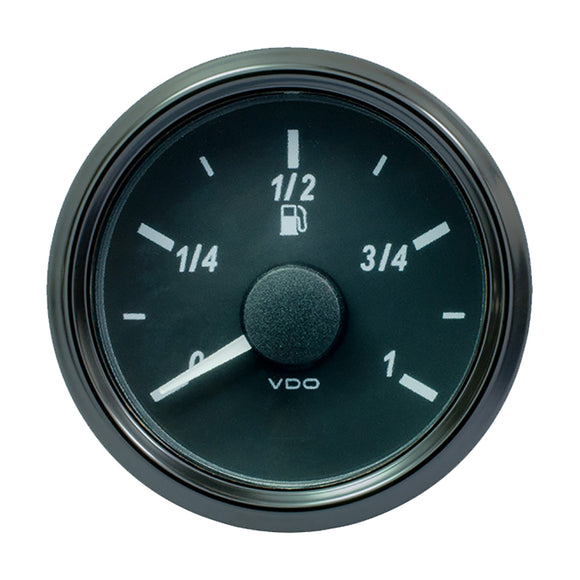
VDO SingleViu 52mm (2-1/16") Fuel Level Gauge - Euro - 90-5 Ohm [A2C3833110030]
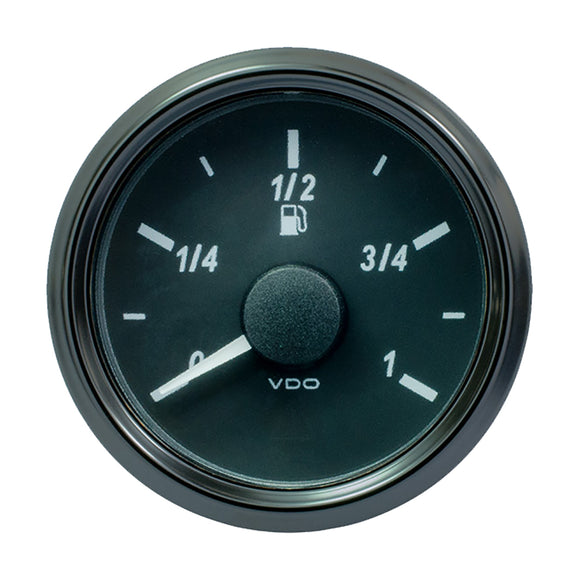
VDO SingleViu 52mm (2-1/16") Fuel Level Gauge - Euro - 3-180 Ohm [A2C3833100030]
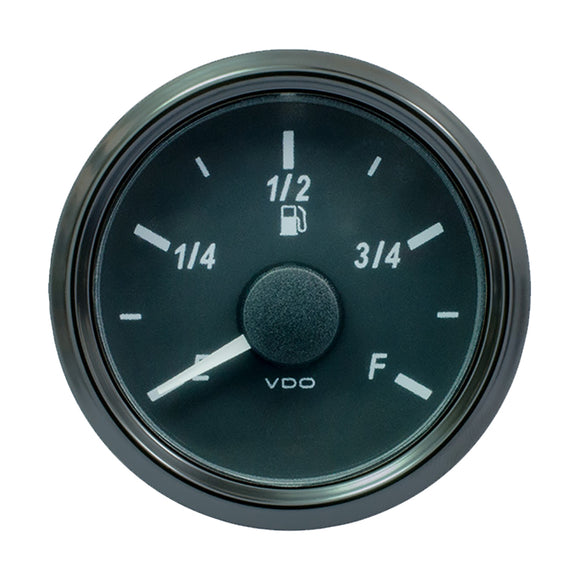
VDO SingleViu 52mm (2-1/16") Fuel Level Gauge - E/F Scale - 0-90 Ohm [A2C3833140030]
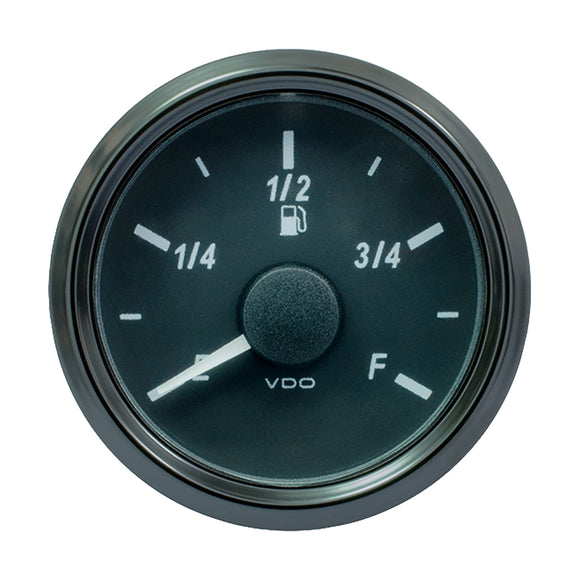
VDO SingleViu 52mm (2-1/16") Fuel Level Gauge - E/F Scale 240-33 Ohm [A2C3833130030]
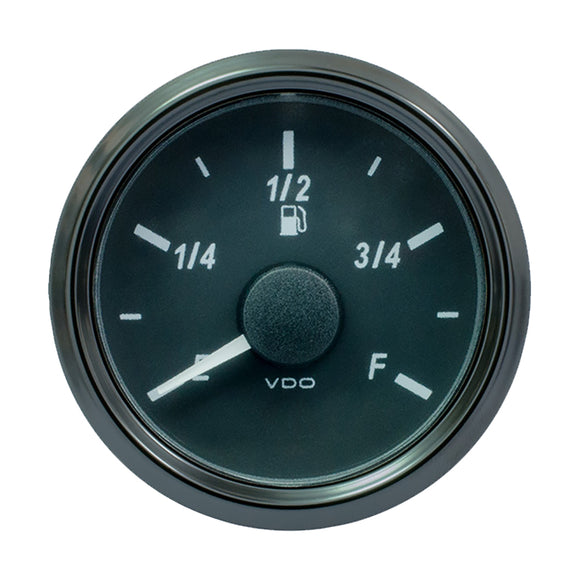
VDO SingleViu 52mm (2-1/16") Fuel Level Gauge - E/F Scale - 0-180 Ohm [A2C3833120030]
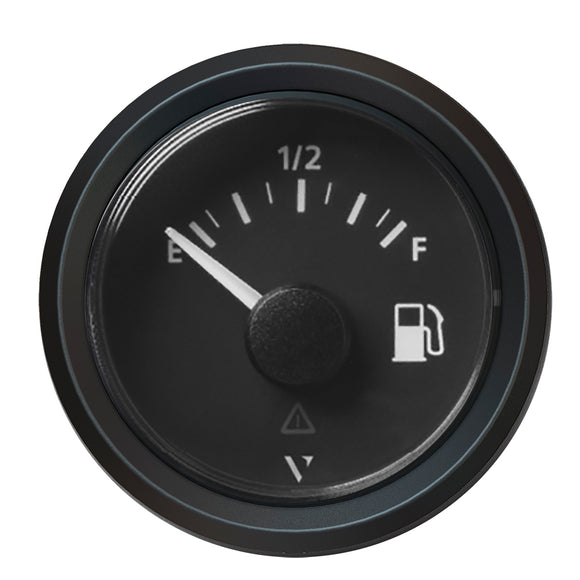
Veratron 52MM (2-1/16") ViewLine Fuel Level Gauge Empty/Full - 240 to 33.5 OHM - Black Dial Triangular Bezel [A2C59514096]
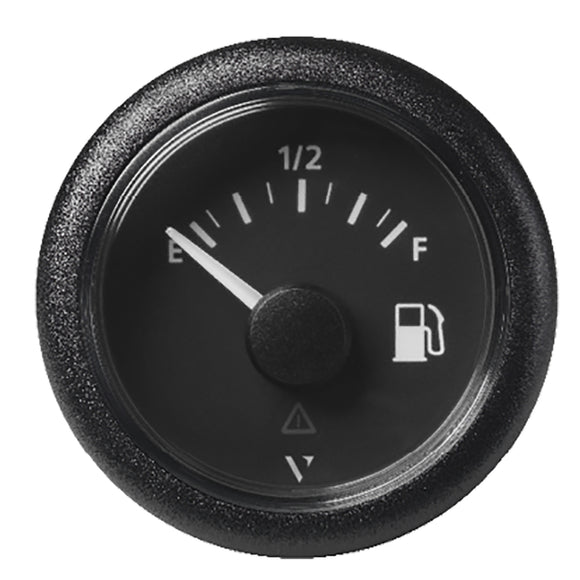
Veratron 52MM (2-1/16") ViewLine Fuel Level Gauge Empty/Full - 240-33.5 OHM - Black Dial Round Bezel [A2C59514094]
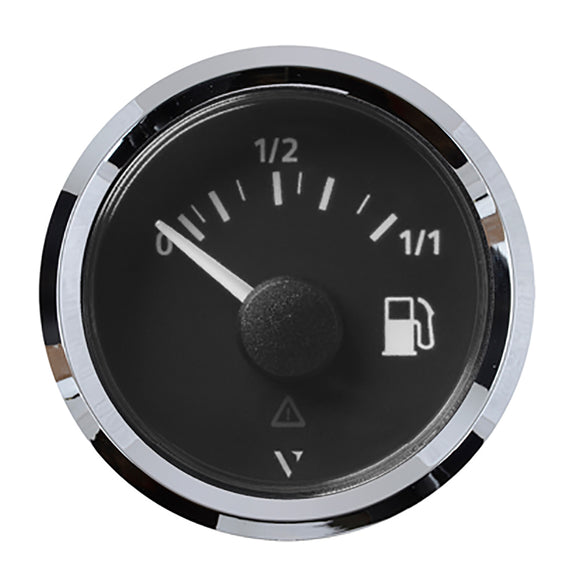
Veratron 52MM (2-1/16") ViewLine Fuel Level Gauge 0-1/1 - 3-180 OHM - Black Dial Chrome Triangular Bezel [A2C59514083]
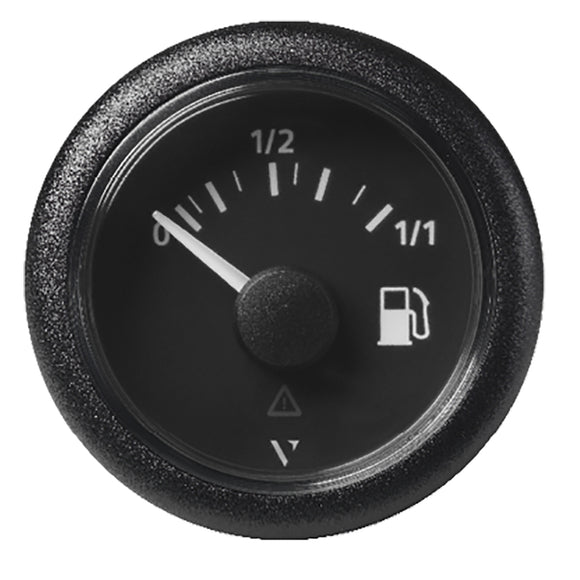
Veratron 52MM (2-1/16") ViewLine Fuel Level Gauge 0-1/1 - 3 to 180 OHM - Black Dial Round Bezel [A2C59514082]
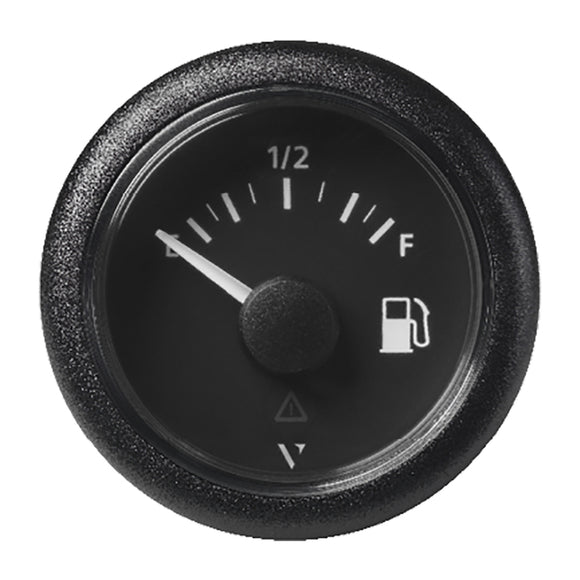
Veratron 52MM (2-1/16") ViewLine Fuel Level Gauge Empty-Full - 0-90 OHM - Black Dial Round Bezel [A2C59514085]

Veratron 52MM (2-1/16") ViewLine Fuel Level Gauge Empty-Full - 90-4 OHM - Black Dial Round Bezel [A2C59514088]
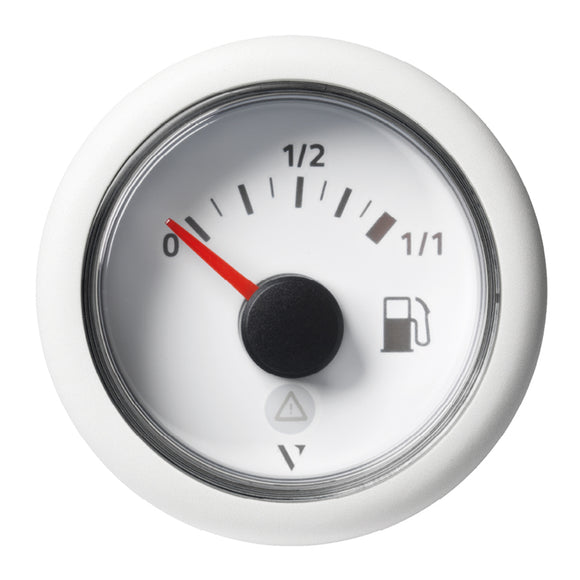
Veratron 52mm (2-1/16") ViewLine Fuel Tank Level Gauge - 0 to 1/1 - White Dial Round Bezel [A2C59514182]
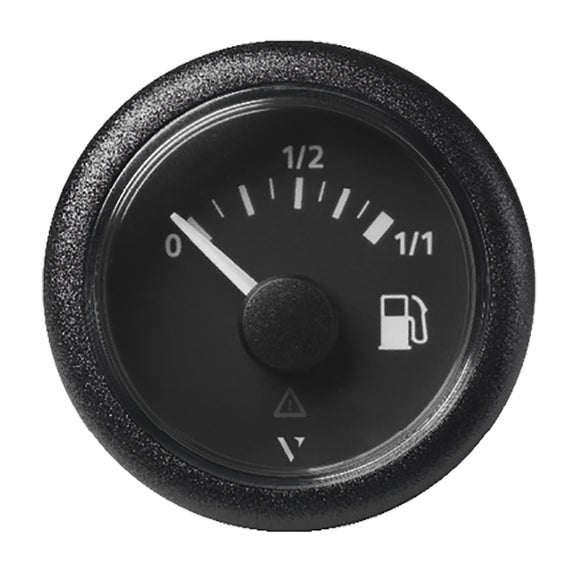
Veratron 52mm (2-1/16") ViewLine Fuel Tank Level Gauge - 0 to 1/1 - Black Dial Round Bezel [A2C59514079]
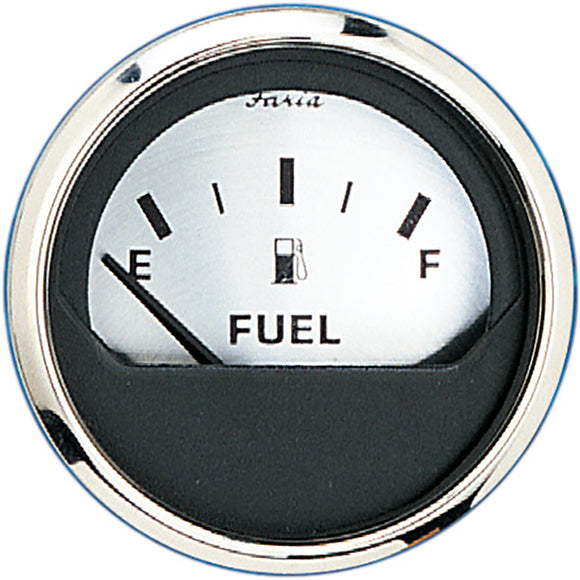
Faria Spun Silver 2" Fuel Level Gauge (E-1/2-F) [16001]
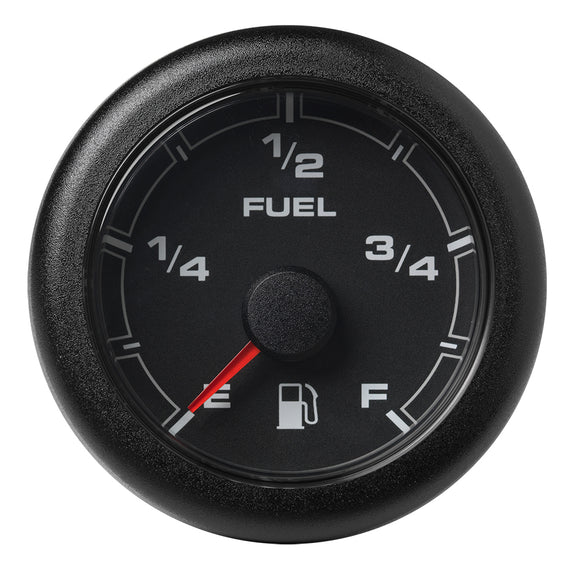
Veratron 52MM (2-1/16") OceanLink Fuel Level Gauge - Black Dial Bezel [A2C1065930001]
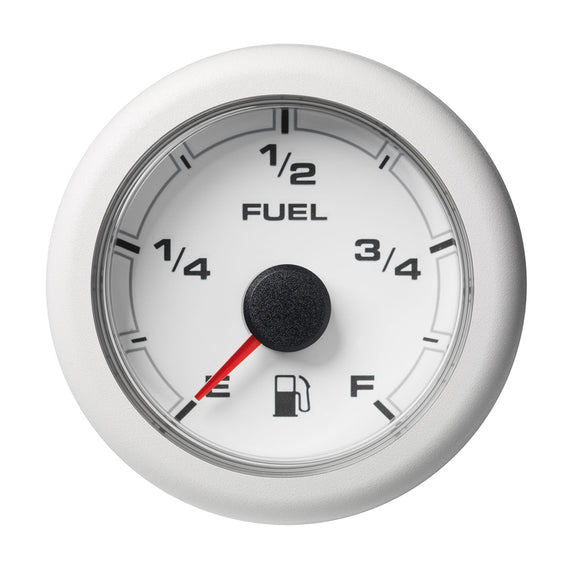
Veratron 52MM (2-1/16") OceanLink Fuel Level Gauge - White Dial Bezel [A2C1065940001]

VDO Cockpit Marine 85mm (3-3/8") 4 in 1 Gauge - White Dial/Bezel [110-15800]
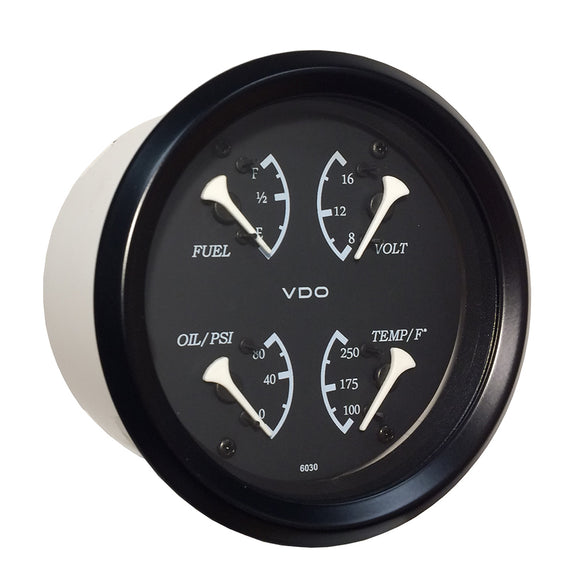
VDO Cockpit Marine 85mm (3-3/8") 4 in 1 Gauge - Black Dial/Bezel [110-11700]
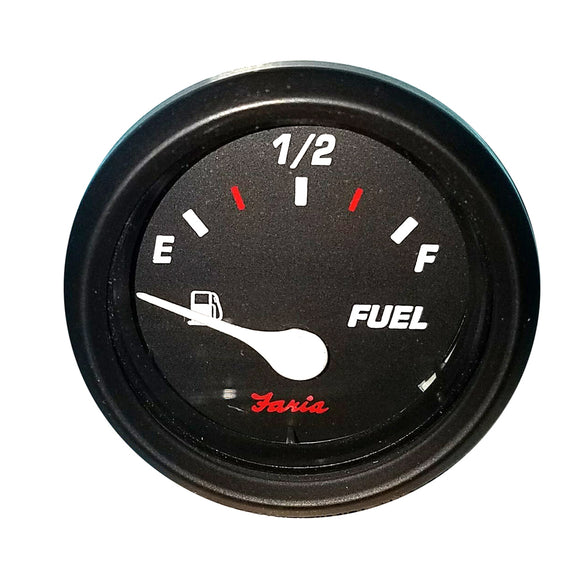
Faria Professional 2" Fuel Level Gauge [14601]
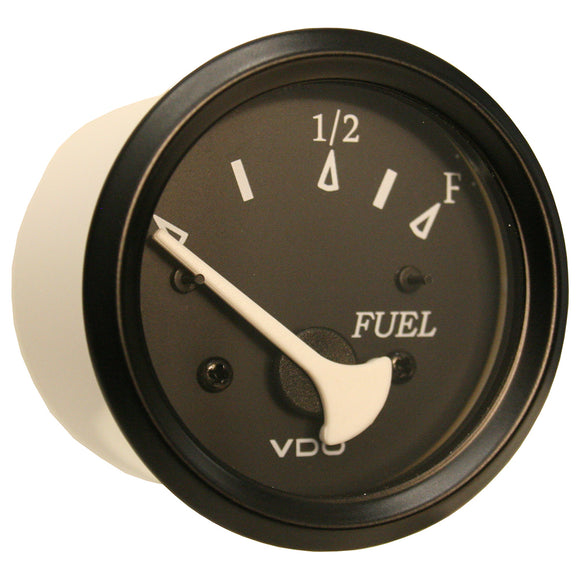
VDO Cockpit Marine 52mm (2-1/16") Fuel Level Gauge - Black Dial/Bezel [301-11802]

Faria Newport SS 4" Multifunction Gauge [45012]
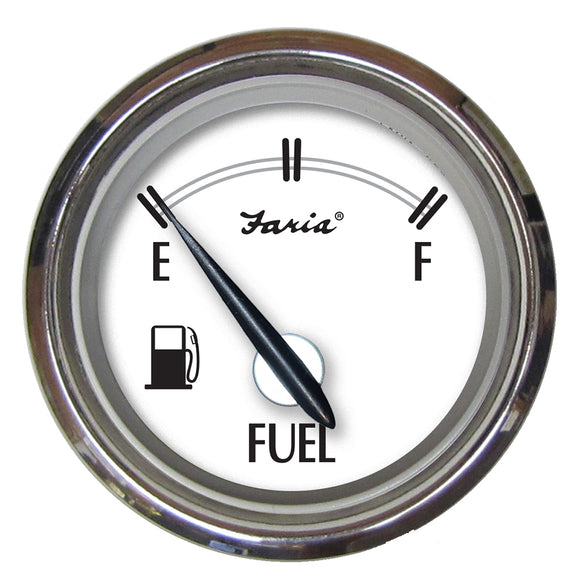
Faria Newport SS 2" Fuel Level Gauge - E-1/2-F [25000]
- choosing a selection results in a full page refresh
- Moeller Marine
Fueling the Fun
- Fuel Senders & Gauges
- Fuel Accessories
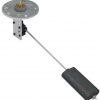
Electric (6)
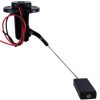
Universal (4)
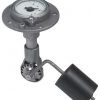
Mechanical (11)
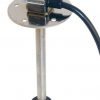
Reed Style (10)
- Where to Buy
- Frequently Asked Questions
- Product Information
- Quality Policy
- Regulations
- 2011 Regulations Simplified
- Ethanol Guidelines
- Industry Organizations and Regulatory Agencies
- Builders Technical Resources
- Moeller Engineering Services
- Tooling Capability
- Custom Tank Design
- Internal Venting
- Plastic vs. Aluminum
- Diurnal Components
- Fuel Connectors
- Fuel Senders & Gauges
- Fuel Line Assemblies & Fittings
- Fuel Water Separator/Filters
- Motor Flushers
- Fuel Containment
- Portable Fuel Tanks
- Topside Fuel Tanks
- Permanent Fuel Tanks
- Fuel Transport
- Marine Accessories
- Fluid Extractors
- Water/Waste Tanks
- Battery Accessories
- Drain Plugs/Tubes/ Grommets
- Dock Carts/Accessories

Please verify you are a human
Access to this page has been denied because we believe you are using automation tools to browse the website.
This may happen as a result of the following:
- Javascript is disabled or blocked by an extension (ad blockers for example)
- Your browser does not support cookies
Please make sure that Javascript and cookies are enabled on your browser and that you are not blocking them from loading.
Reference ID: 79c9ac4d-f36d-11ee-9f89-580b36e5f0ac
Powered by PerimeterX , Inc.

Boating Basics Online is reader-supported. When you buy via our links, we may earn a commission at no cost to you. Learn more
Boat Fuel Gauge Not Working – Troubleshooting Guide
Written by J. Harvey / Fact checked by S. Numbers
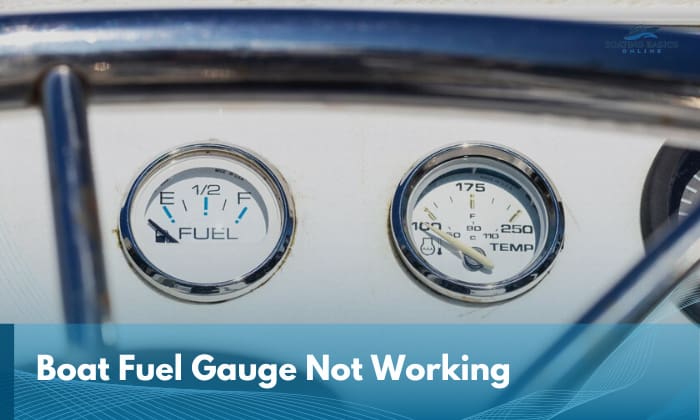
A gas gauge is a device that tells you how much fuel you still have based on various resistance changes its sender unit detects. If the issue of the boat fuel gauge not working arises, you’ll see symptoms such as its float arm being stuck on empty or full, fluctuating, not working altogether, etc.
A broken fuel gauge is challenging to remedy because it can be caused by numerous things , such as damaged fuel gauge wiring or a faulty sending unit. Other culprits include wear and tear and grounding problems.
In order to know how to tell if a boat fuel gauge is bad, you need to learn how it works in greater detail. So read on!
Table of Contents
1. Test the Fuel Sender
2. test the fuel gauge, 3. test the gauge’s assembly, what to keep in mind while testing boat fuel gauge, troubleshooting and fixing a boat fuel gauge.
Below are the best ways to test a fuel gauge on a boat without requiring any advanced technical skill. By determining the root causes, you’ll be able to figure out the best way to fix fuel gauge on boat.
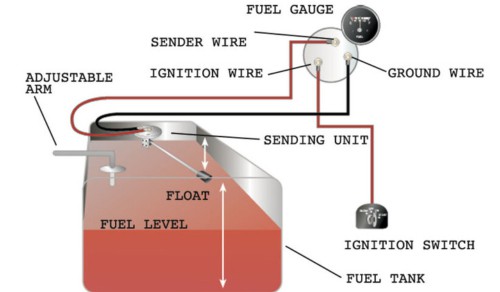
Diagnosing any problem related to boat fuel gauges requires you to be aware of one important fact: Most hitches are caused by the sending unit or fuel sender in the tank , which is usually why any fuel gauge on a boat is not working anymore.
The takeaway here is: you’ll need to test the sender unit’s resistance to determine whether it’s defective, in which case replacement is necessary.
When doing any test, you’ll need to remove the gauge’s fuel sender first. Where it’s located depends on the type of boat or model you have, but most manufacturers place it in the middle of the boat.
Here’s how the test usually goes:
- Figure out how to remove the sending unit from the tank by referring to the manufacturer’s manual and disconnecting the wires.
- From there, set a multimeter to the lowest ohm setting to check the fuel sender’s resistance.
- Use the multimeter’s black probe to ground the sending unit, then touch the end of the power wire with the red probe.
- Move the sending unit’s float across the arm to start checking. Its resistance reading should increase as you move the arm closer to the unit’s body and decrease as you pull it away.
- The ideal sending unit’s resistance will vary from one model to another, so you’ll have to check your boat’s specifications. If you can find none, just make sure the resistance changes according to the float’s movement.
- If you’re not getting any resistance or the reading doesn’t change according to the float’s movement, it’s likely that your sender unit already needs to be replaced. The same applies to the instance where the reading is outside the recommended range.
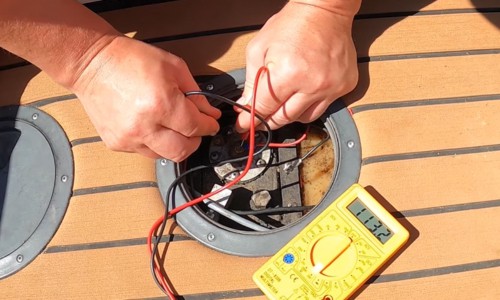
What if the method above didn’t solve the problem (e.g., still stuck on full , stuck on empty, or drops below empty )? If that’s so, I suggest you examine its needle .
Take note of this before handling its wiring, though: Typically, a fuel gauge installatio n will have three wires connected to the sending unit, namely a ground wire (black), a sender wire (pink), and a power wire (either purple or yellow).
- Disconnect the sender wires and ground wires attached to the sender unit, then turn the key to the ‘On’ position.
- Afterward, touch the two wires together. Once you do, the gauge’s needle should jump to ‘Full,’ which is a sign that it’s still good to go, as well as most of the wiring.
What if the needle doesn’t spike? You’ll need to do a simple voltage test on the gauge or the sending unit’s wires, to be exact.
- Set the multimeter to measure voltage.
- Touch the probes to the ground and power wires attached to the terminals on the back of the fuel gauge. You should at least get a reading of 12V.
- No voltage spells trouble, especially if there are no issues with the power source, wires, or fuse.
If your gauge’s needle is stuck on the ¾ mark or you encounter this issue after a battery change, there’s a chance it is stuck, or something is causing it to snag on other parts of the tank .
If this is the case, you can usually adjust the orientation of the swing arm and float by loosening the nuts on top of the sending unit in 90-degree turns.
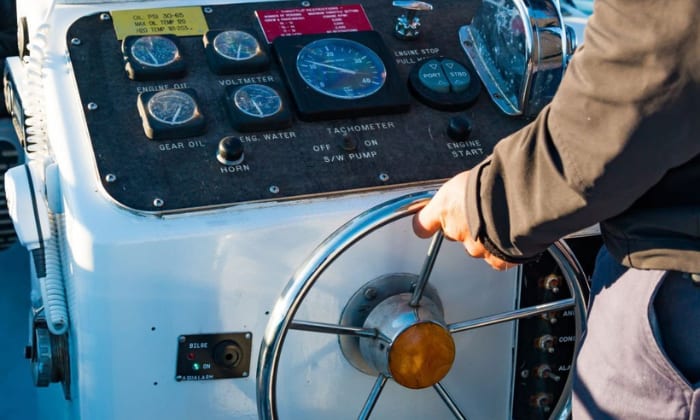
When doing any of the wire tests, you need to account for the fact that not all gauges are the same nowadays. For example, you may have a digital fuel gauge system with a different wiring rig than others.
Refer to official documentation and a wiring diagram before doing any test procedures or boat fuel sending unit repair involving them to be completely safe and sure.
If the result on the multimeter fluctuates or is not reading correctly, it may be time to replace it or have a professional check, repair, and replace the unit for you.
We all need to accept that the problem of the boat fuel gauge not working is fairly commonplace. It’s also a hurdle that needs to be addressed seriously because how else will you be able to know whether your boat still has enough fuel or not?
Again, most problems stem from a defective fuel sender or improper wiring, so don’t hesitate to try doing the tests shared here. If you’re not confident with your technical skills, just let a pro handle it.

“My intention from the first day establishing Boating Basics Online is to provide as much help as possible for boaters who want to experience a first safe and convenient trip. So feel free to join us and share your beautiful journeys to the sea!”
Advertisement
Supported by
Baltimore Investigation Turns to Ship’s Deadly Mechanical Failure
The Dali reported a power blackout and steering problems before hitting the Francis Scott Key Bridge in Baltimore. But what went wrong so far has not been explained.
- Share full article

By Mike Baker and Peter Eavis
Just minutes before the cargo ship Dali was set to glide under Baltimore’s Francis Scott Key Bridge, the ship’s alarms began to blare. The lights went out. The engine halted. Even the rudder, which the crew uses to maneuver the vessel, was frozen.
As a frantic effort to restore the ship was underway, the pilot soon recognized that the aimless vessel was drifting toward disaster, and called for help.
The cascading collapse of the vessel’s most crucial operating systems left the Dali adrift until it ultimately collided with the Key bridge, knocking the span into the river and killing six people. But as crews this week were still sorting out how to disentangle the ship and recover the bodies of those who died, investigators were also turning to the most central question: What could have caused such a catastrophic failure at the worst possible moment?
Engineers, captains and shipping officials around the world are waiting for that answer in an era when the industry’s largest ships can carry four times as much cargo as those just a few decades ago, navigating through congested urban ports under bridges that may carry tens of thousands of people a day,
Already, a few key questions are emerging, according to engineers and shipping experts monitoring the investigation, and most of them point to the electrical generators that power nearly every system on the 984-foot vessel, not only the lights, navigation and steering, but the pumps that provide fuel, oil and water to the massive diesel engine.
The “ complete blackout ” reported by the pilot is hard to explain in today’s shipping world, in which large commercial vessels now operate with a range of automation, computerized monitoring, and built-in redundancies and backup systems designed to avert just such a calamity.
“In the last 30 to 40 years, the level of that redundancy has been increasing quite considerably,” said John Carlton, a professor of marine engineering at City, University of London. “The ship of today is so very different to the one of 30 years ago.”
Yet there is a wide range of possible factors contributing to the failure that investigators will have to sift through as they interview crew members, examine fuel supplies and scrutinize the ship systems that broke down that night.
If there was faulty maintenance, it could have caused a delay in starting the emergency backup generator, or an electrical fault could have prevented it from remaining engaged. Contaminated fuel or an inadvertently closed valve could have fouled or starved the main generators. Human error could have set off problems or failed to overcome them. The ship’s own automation could have led to equipment glitches. Or a fire could have broken out and damaged crucial equipment.
The answers will have implications not only for international shipping but also for who is liable for damages that S&P Global Ratings estimated at more than $2 billion.
Grace Ocean Private, the Singapore-based company that owns the Dali, said it was “fully cooperating with federal and state government agencies.” Grace Ocean’s owner is Yoshimasa Abe, a Japanese citizen who owns at least two shipping lines and more than 50 vessels, including some of the world’s biggest container ships. While the Dali was insured, Mr. Abe’s company potentially faces large claims against it, depending on the findings of the accident investigators.
Given the scope of the failure, it is possible that there were multiple problems. Timothy McCoy, a professor specializing in marine engineering at the University of Michigan, said that much like a plane crash, an extensive breakdown of a ship’s systems typically involves a sequence of events.
A close look at the potential factors would include many of the most essential elements in the operation of a modern cargo vessel — including the fuel that feeds the ship’s 55,000-horsepower diesel engine that in turn powers the ship’s propeller.
Fuel also powers the huge generators that provide electricity to container ships. And a ship like the Dali needs electrical power to run its main engine — its fuel injectors are electrically powered, for instance — and steer its rudder. Without electricity, the ship can go adrift.
An outbreak of contaminated fuel led to reported problems with 32 vessels from Texas to Singapore last August, maritime industry officials reported , with some of them reporting loss of power and propulsion at sea.
In Washington State last year, a large passenger ferry ran aground after losing power as a result of bacterial and fungal growth in the vessel’s fuel tanks that fouled the ship’s filtration systems.
At the time it was built, 2015, the Dali had four generators, according to S&P Maritime Portal, a shipping data service. Not all of them run at once, usually, but container vessels leaving port will typically have an extra generator running, to provide reserve power if needed. “At least two should be online at the same time,” said Mark Bulaclac, an academic on maritime issues who has also served as an engineer on container ships.
If all generators were running on a common source of bad fuel, that might have caused them all to fail.
Henry Lipian, a forensic crash investigator who previously worked in the Coast Guard, said the sudden loss of the ship’s generators led him to think of fuel problems as a potential culprit.
He said investigators would need to look at the fuel on board, how it was delivered, whether it had been tested beforehand and what filtration systems were on the ship. But he said that a problem with the fuel valves could be another explanation.
“I’d want to start tracing all of those fuel lines,” he said.
In Baltimore, investigators were in the process of collecting a fuel sample from the Dali in order to examine the quality, viscosity and signs of any contaminants, said Jennifer Homendy, the chair of the National Transportation Safety Board.
Yet other experts said there were also reasons to doubt the contaminated fuel scenario. New fuels typically undergo testing, and duplicate filtration systems can help clean out problematic components that were not flagged in testing. No reports have emerged of other ships having a problem from the same batch of fuel.
Maritime engineers say an electrical chain reaction could also have caused all the generators to go down. When one generator fails, it can create a situation in which there is too much demand for too little supply of electricity. Other generators are then at risk of being damaged, so the system will shut them down, too, said Richard Burke, a professor of naval architecture and marine engineering at SUNY Maritime College in New York.
“It’s as if you and I are both holding up a heavy weight and I let go,” he said, “You can’t hold it by yourself, so you drop the weight.”
A haywire generator could also zap the electrical distribution system on the ship, said Capt. Morgan McManus, an instructor at SUNY Maritime College.
When all the main generators fail, ships rely on a backup generator that is typically situated above the water line in another area of the ship, with its own fuel source.
Marine engineers say backup generators provide electricity to run some lights, the navigation system — and, crucially, the ship’s steering system. Without at least backup power, the rudder cannot be moved.
Because some lights came back on after the Dali experienced its initial blackout, it appears the backup generator did activate, but only after a roughly one-minute delay. Even then, the lights appeared to go back off, then on again, raising the possibility of a problem with the backup generator.
Ms. Homendy of the N.T.S.B. said this week that investigators had collected data “consistent with a power outage” but were still trying to determine the extent.
Clay Diamond, the head of the American Pilots’ Association, a trade group that has been in close contact with the harbor pilots in Maryland, said that steering was restored after the emergency generator came online. But even with a hard turn to the left and the dropping of an anchor, there was not enough time to turn or stop the ship.
Mr. Bulaclac, the shipping engineer, said backup generators are meant to be regularly tested by turning them on for two hours once a month. “What I would like to know is when that emergency diesel generator was last tested,” he said.
The Coast Guard inspected the Dali when it docked in the Port of New York in September but found no deficiencies on the ship. The Coast Guard did not provide details of what it inspected.
The modernization of ships may have introduced other ways vessels can fail. They have increasingly depended on computers to monitor for troubles and take action when a problem is identified. In some ways, this is a built-in layer of automatic protection: If one component gets overloaded, it can be automatically shut down to prevent further damage. But those shutdowns can cause problems on their own.
“I could not rule out that some computer failure shut all the valves off or shut off pumps that provide the fuel,” Mr. Lipian said.
Michael Forsythe and Jenny Gross contributed reporting.
Mike Baker is a national reporter for The Times, based in Seattle. More about Mike Baker
Peter Eavis reports on business, financial markets, the economy and companies across different sectors. More about Peter Eavis
- Bahasa Indonesia
- Slovenščina
- Science & Tech
- Russian Kitchen
Cruising the Moskva River: A short guide to boat trips in Russia’s capital

There’s hardly a better way to absorb Moscow’s atmosphere than on a ship sailing up and down the Moskva River. While complicated ticketing, loud music and chilling winds might dampen the anticipated fun, this checklist will help you to enjoy the scenic views and not fall into common tourist traps.
How to find the right boat?
There are plenty of boats and selecting the right one might be challenging. The size of the boat should be your main criteria.
Plenty of small boats cruise the Moskva River, and the most vivid one is this yellow Lay’s-branded boat. Everyone who has ever visited Moscow probably has seen it.

This option might leave a passenger disembarking partially deaf as the merciless Russian pop music blasts onboard. A free spirit, however, will find partying on such a vessel to be an unforgettable and authentic experience that’s almost a metaphor for life in modern Russia: too loud, and sometimes too welcoming. Tickets start at $13 (800 rubles) per person.
Bigger boats offer smoother sailing and tend to attract foreign visitors because of their distinct Soviet aura. Indeed, many of the older vessels must have seen better days. They are still afloat, however, and getting aboard is a unique ‘cultural’ experience. Sometimes the crew might offer lunch or dinner to passengers, but this option must be purchased with the ticket. Here is one such option offering dinner for $24 (1,490 rubles).

If you want to travel in style, consider Flotilla Radisson. These large, modern vessels are quite posh, with a cozy restaurant and an attentive crew at your service. Even though the selection of wines and food is modest, these vessels are still much better than other boats.

Surprisingly, the luxurious boats are priced rather modestly, and a single ticket goes for $17-$32 (1,100-2,000 rubles); also expect a reasonable restaurant bill on top.
How to buy tickets?
Women holding photos of ships promise huge discounts to “the young and beautiful,” and give personal invitations for river tours. They sound and look nice, but there’s a small catch: their ticket prices are usually more than those purchased online.
“We bought tickets from street hawkers for 900 rubles each, only to later discover that the other passengers bought their tickets twice as cheap!” wrote (in Russian) a disappointed Rostislav on a travel company website.
Nevertheless, buying from street hawkers has one considerable advantage: they personally escort you to the vessel so that you don’t waste time looking for the boat on your own.

Prices start at $13 (800 rubles) for one ride, and for an additional $6.5 (400 rubles) you can purchase an unlimited number of tours on the same boat on any given day.
Flotilla Radisson has official ticket offices at Gorky Park and Hotel Ukraine, but they’re often sold out.
Buying online is an option that might save some cash. Websites such as this offer considerable discounts for tickets sold online. On a busy Friday night an online purchase might be the only chance to get a ticket on a Flotilla Radisson boat.
This website (in Russian) offers multiple options for short river cruises in and around the city center, including offbeat options such as ‘disco cruises’ and ‘children cruises.’ This other website sells tickets online, but doesn’t have an English version. The interface is intuitive, however.
Buying tickets online has its bad points, however. The most common is confusing which pier you should go to and missing your river tour.

“I once bought tickets online to save with the discount that the website offered,” said Igor Shvarkin from Moscow. “The pier was initially marked as ‘Park Kultury,’ but when I arrived it wasn’t easy to find my boat because there were too many there. My guests had to walk a considerable distance before I finally found the vessel that accepted my tickets purchased online,” said the man.
There are two main boarding piers in the city center: Hotel Ukraine and Park Kultury . Always take note of your particular berth when buying tickets online.
Where to sit onboard?
Even on a warm day, the headwind might be chilly for passengers on deck. Make sure you have warm clothes, or that the crew has blankets ready upon request.
The glass-encased hold makes the tour much more comfortable, but not at the expense of having an enjoyable experience.

Getting off the boat requires preparation as well. Ideally, you should be able to disembark on any pier along the way. In reality, passengers never know where the boat’s captain will make the next stop. Street hawkers often tell passengers in advance where they’ll be able to disembark. If you buy tickets online then you’ll have to research it yourself.
There’s a chance that the captain won’t make any stops at all and will take you back to where the tour began, which is the case with Flotilla Radisson. The safest option is to automatically expect that you’ll return to the pier where you started.
If using any of Russia Beyond's content, partly or in full, always provide an active hyperlink to the original material.
to our newsletter!
Get the week's best stories straight to your inbox
- What to do in Moscow City, if you’re not mega-rich
- Moscow after dusk: 10 places to drink, dance, and groove
- 5 things you must do in Moscow in 2018 between football matches (or without them)
- Sandwiched between Moscow and St. Petersburg: How to spend a perfect weekend in Tver
- 24 or 48 hours in Moscow: Where to go and what to do in 2019
This website uses cookies. Click here to find out more.

IMAGES
VIDEO
COMMENTS
engine instruments. marine gauges. fuel gauges. CONTACT WEST MARINE. Live Chat. 1-800-262-8464. Store Locator. Shop the best selection of Fuel Gauges from West Marine. Visit for products, prices, deals and more!
Marine Fuel Gauge Boat Gauge Fuel Gauge Aftermarket Fuel Level Gauge Marine Automotive Replacement Gauge 240-33ohm 0-190ohm 240-30ohm 0-180ohm 10-180ohm Motocycle Car Truck Vehicle All Black. 4.4 out of 5 stars. 336. 100+ bought in past month. $28.99 $ 28. 99. Join Prime to buy this item at $26.09.
Fuel gauges are important instruments keeping you aware of the fuel efficiency and performance of your boat. It can be a gauge showing the current volume of hydrocarbons in the tank, pressure in the rail, air-to-fuel ratio, etc.While the fuel level gauge gives you a general idea of how much gas or diesel remains in the vessel, the information from other instruments can be more critical for ...
The sender is held in place by 5 machine screws. Remove the power and ground wire. Remove the five machine screws holding the sender in place. The bolt pattern is a marine standard so for replacement we just need to know the length of the sender. When removing the fuel sender and gasket take care to make sure which direction the arm swings.
Most fuel gauges are the standard 2 1/8-inch diameter. To replace, disconnect the wiring from the existing gauge and remove the holding bracket using a nut driver or socket. Remove the gauge, install the new gauge, and reconnect the wires. Read Next: Boat Fuel Tank Vent Tips. The sender is trickier.
Fuel Level Senders. Our range of marine fuel gauges and fuel level senders are designed to reliably monitor and display the fuel level in your boat, whilst adding a stylish fuel gauge to match your dashboard. We supply boat fuel gauges from Faria Beede and Vetus suitable for 12 volt and 24 volt electrical systems.
Boat Fuel Gauges. Don't let a faulty fuel gauge spoil a day on the water. Get boat gas gauges at closeout prices from Great Lakes Skipper. We have dozens of marine fuel gauges, both digital fuel gauges and analog gas gauges, in all sizes and colors. Check our selection of boat fuel gauges from brands like Livorsi, Teleflex, Faria, Beede, and more.
Shop SIERRA Lido Series Fuel Gauge at West Marine. Visit for prices, reviews, deals and more! Enter Zip Code ×. Use my current location ... Lido Series Fuel Gauge 5 out of 5 Customer Rating Model # 5343470 Mfg # 65496P. $52.99 Model # 5343470 Mfg ...
The fuel gauge on boats serves a crucial role in providing a visual representation of the fuel level in the boat's fuel tank. It allows boaters to monitor the amount of fuel remaining, ensuring efficient trip planning and avoiding fuel-related issues. The fuel gauge typically consists of a display or indicator on the boat's dashboard that ...
This way, whenever you turn the key ON, the gauge receives power and turns on the fuel gauge system. These are usually a yellow or purple wire (depending on what brand engine you have on your boat). Make sure that wire has battery voltage on it going to the gauge. If there is an issue with the power going to the gauge.
We only carry the best marine gauges from VDO, Veratron and Faria Beede. Don't settle for less. Sign in or Create an Account. Search. Cart 0. Menu. Cart 0. Search. Home SHOP ALL MARINE GAUGES VERATRON GAUGES FARIA BEEDE GAUGES ... VDO Cockpit Marine 52MM (2-1/16") Fuel Level Gauge - White Dial/Chrome Bezel [301-15278] Sale price $20 24 $20.24 ...
Marine Fuel Gauge Boat Gauge Fuel Gauge Aftermarket Fuel Level Gauge Marine Automotive Replacement Gauge 240-33ohm 0-190ohm 240-30ohm 0-180ohm 10-180ohm Motocycle Car Truck Vehicle All Black. 4.5 out of 5 stars. 336. 100+ bought in past month. $28.99 $ 28. 99. 10% coupon applied at checkout Save 10% with coupon.
This is a short and sweet explanation of where to run your wires when you're installing a new fuel tank, fuel gauge, or entire fuel system on your boat. Reme...
Moeller Marine Products 801 North Spring St. Sparta, TN 38583 Tel: 1-931-738-8090 Fax: 931-738-9835
Geloo Marine Fuel Gauge 52mm Boat Gauge Digital Fuel Gauge Fuel Gas Tank Gauge Fuel Level Gauge Replacement 240-33ohm 0-190ohm Signal Adjustable with 8 Colors Backlight for Motorcycle Boat Car-Black. 4.2 out of 5 stars. 190. $23.23 $ 23. 23. 5% off promotion available. FREE delivery Mon, Apr 8 on $35 of items shipped by Amazon.
A 2" black faced dash mounted fuel gauge completes the kit and allows users to monitor fuel levels day—and night when connected to dash lighting circuit. Key Features. 12V fuel sender is compatible with 4"-27" deep fuel tanks. Sender flange has standard 5 hole pattern and includes gasket for installation. 2" Fuel gauge is calibrated to 33 to ...
1. Test the Fuel Sender. Source: sailmagazine.com. Diagnosing any problem related to boat fuel gauges requires you to be aware of one important fact: Most hitches are caused by the sending unit or fuel sender in the tank, which is usually why any fuel gauge on a boat is not working anymore. The takeaway here is: you'll need to test the sender ...
547. The collapse of the Dali's vital operating systems left the vessel adrift until it ultimately collided with the Francis Scott Key Bridge. Erin Schaff/The New York Times. By Mike Baker and ...
Surprisingly, the luxurious boats are priced rather modestly, and a single ticket goes for $17-$32 (1,100-2,000 rubles); also expect a reasonable restaurant bill on top.
Marine Fuel Gauge - Waterproof Boat Fuel Level Gauge 52mm Universal Fuel Gauge Marine Automotive Replacement Fuel Gauges for Motocycle Car Truck 240-33ohm 0-190ohm 240-30ohm 0-180ohm 10-180ohm. 4.6 out of 5 stars. 8. $25.99 $ 25. 99. FREE delivery Tue, Apr 9 on $35 of items shipped by Amazon.
Rent a boat for the river trip in Moscow with your company of friends. Set up a unique event on a modern and cozy ship. If you want to come ashore we've got bus tours to offer. Choose the route and start the journey. Walking tours in the center of Moscow, with the guide's amazing story, lasting 1.5 hours.
On this map you can see the details of the longest and most classic of the Flotilla Radisson boat tours: 2. Companies that do boat tours on the Moskva River. There are many companies that do cruises on the Moskva River, but the 4 main ones are: Capital River Boat Tour Company (CCK) Mosflot. Flotilla Radisson.
In fact, each boat is a floating restaurant with a terrace and glass-domed windows for sightseeing. The bar on board offers both alcoholic and soft drinks. The navigation is all year round so even in wintertime the Moskva River Cruise is available. Boats depart 5 times a day at 13:00, 15:00, 17:00, 19:00, and 21:00. In winter, the sun goes down ...
BLLYOGU 2" 52mm Fuel Gauge Marine Boat Fuel Level Gauge Car Fuel Gas Tank Gauge 0-190ohm 0-180ohm 240-33ohm 240-30ohm Signal Adjustable Automotive Replacement Gauge for RV Truck Motorcycle Yacht 9-32V. 22. $2199. Join Prime to buy this item at $19.79. FREE delivery Thu, Jan 18 on $35 of items shipped by Amazon.